#Built-in Primer
Text


#amazon#amazon products#amazon deals#amazon shopping#amazon affiliate#deals#REVLON Lipstick#ColorStay Suede Ink#Built-in Primer#Infused with Vitamin E#Waterproof#Smudgeproof#Matte Color#003 Want it All (Pack o
5 notes
·
View notes
Note
Wait, so you said that you can learn to trust others by building friendships, but how does one go about doing that? Wouldn't someone I don't know be creeped out or annoyed if I suddenly walked up and started talking to them?
Friendships are built of repeated low-stakes interactions and returned bids for attention with slowly increasing intimacy over time.
It takes a long time to make friends as an adult. People will probably think you're weird if you just walk up and start talking to them as though you are already their friend (people think it's weird when I do this, I try not to do this) but people won't think it's weird if you're someone they've seen a few times who says "hey" and then gradually has more conversations (consisting of more words) with them.
I cheat at forming adult friendships by joining groups where people meet regularly. If you're part of a radio club that meets once a week and you just join up to talk about radios, eventually those will be your radio friends.
If there's a hiking meetup near you and you go regularly, you will eventually have hiking friends.
Deeper friendships are formed with people from those kinds of groups when you do things with them outside of the context of the original interaction; if you go camping with your radio friend, that person is probably more friend than acquaintance. If you go to the movies with a hiking friend who likes the same horror movies as you do, that is deepening the friendship.
In, like 2011 Large Bastard decided he wanted more friends to do stuff with so he started a local radio meetup. These people started as strangers who shared an interest. Now they are people who give each other rides after surgery and help each other move and have started businesses together and have gone on many radio-based camping trips and have worked on each other's cars.
Finding a meetup or starting a meetup is genuinely the cheat-code for making friends.
This is also how making friendships at schools works - you're around a group of people very regularly and eventually you get to know them better and you start figuring out who you get along with and you start spending more time with those people.
If you want to do this in the most fast and dramatic way possible, join a band.
In 2020 I wrote something of a primer on how to turn low-stakes interactions with neighbors and acquaintances into more meaningful relationships; check the notes of this post over the next couple days, I'll dig up the link and share it in a reblog.
14K notes
·
View notes
Text
In other news the Cedo is proving to be fun so far, tho I do still gotta take it for a spin outside of levelling it
I’m not a fan of status priming as a strategy bc it just feels like it breaks the flow of things for me, but this gun actually makes it feel pretty okay?? Part of that is bc i don’t need to be switching weapons constantly. But even when it was entirely unlevelled, so the primary fire was garbage and i was using it to unleash its glaive and then delete everything with the xoris, it was still fun! Probably bc the lil glaive flies all over the place and i don’t need to actually aim it strategically
#no i dont use a primer yes i have condition overload on the xoris anyway bc thats kind of a given i feel like#i have it built somewhat for status and even if i didnt. it forces two procs#so if something survives the first hit i immediately get bonus damage against them on the next one#anyway! cedo probably fun and also pretty#but i gotta take it into an actual mission about it tomorrow#dicking around on hydron hardly counts as a proper test and taking it into simulacrum slipped my mind#kata's chatter#space ninja fashion show
0 notes
Text
well hello! it is me, your lad kris.
i make historical fantasy art and comics, in which the characters are largely some flavour of monsterfolk and often queer. in addition to here, you can also find me on instagram and twitter, or just check my website (there's a lot there). and for that porn i talk so much about, but cant post here, there is this website and a separate twitter. (and now also a patreon and subscribestar, wheee!)
now with links out of the way -- let me introduce the ongoing series!
as a primer, the settings in both are bigly influenced by finnish history and folklore, more or less shamelessly at any given time. the unifying anachronism is the exclusion of period-typical queerphobia.
1816
betwixt two men in the early 19th century, yearslong friendship turns to a complicated romance. drama ensues as we navigate amidst flaws of character, aftermath of war and variety of socioeconomic status.
low action, heavy in dialogue.
features sexually explicit scenes, as such intended for a mature audience only. (over here on tumblr, these parts are cut out)
read on tumblr or website
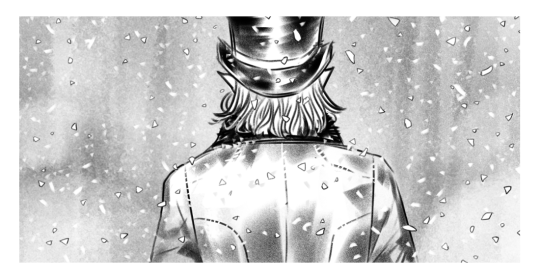
1866 (on hiatus)
in the midst of a famine, a railroad is being built. three travel towards it through a largely deserted countryside, focused on the promise of work and therein survival.
on the way, new friends and conflict aplenty be run into, sometimes in tandem.
exists in both finnish and english.
features depictions of ptsd and gender dysphoria.
read on tumblr or website
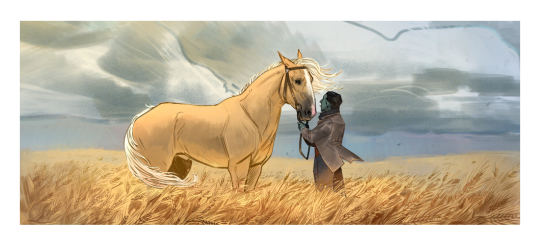
161 notes
·
View notes
Text
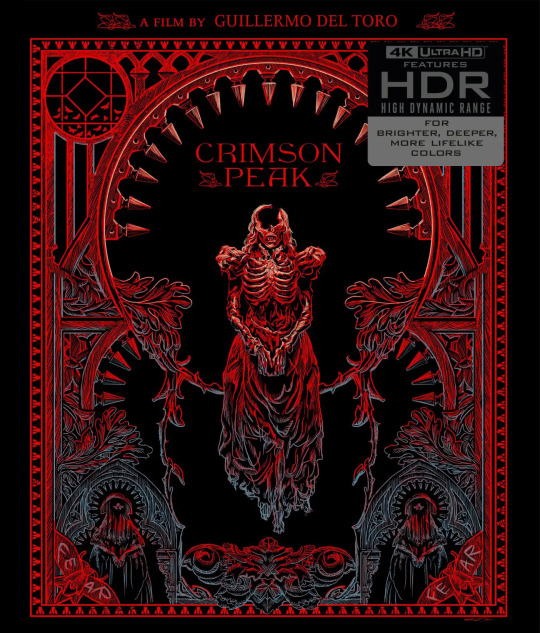
Crimson Peak will be released on 4K Ultra HD on May 21 via Arrow Video. Guy Davis, the film’s concept artist, designed the packaging for the 2015 Gothic horror/romance.
Master of horror Guillermo del Toro directs from a script he co-wrote with frequent collaborator Matthew Robbins (Mimic, Pinocchio). Mia Wasikowska, Jessica Chastain, Tom Hiddleston, Charlie Hunnam, and Jim Beaver star.
The limited edition set comes with a double-sided fold-out poster, four double-sided postcards, and an 80-page book featuring writings by David Jenkins and Simon Abrams, an interview with Guillermo del Toro, and conceptual illustrations by Guy Davis and Oscar Chichoni, all housed in a slipcase.
Crimson Peak is presented in 4K with Dolby Vision, approved by del Toro, and original DTS:X Master Audio sound. Special features are listed below, where you can also see the full packaging.

Special features:
Audio commentary by director/co-writer Guillermo Del Toro
The House is Alive: Constructing Crimson Peak - Feature-length documentary with cast and crew interviews and behind the scenes footage
Spanish-language interview with Guillermo Del Toro
The Gothic Corridor; The Scullery; The Red Clay Mines; The Limbo Fog Set - Four featurettes on Allerdale Hall
A Primer on Gothic Romance featurette
The Light and Dark of Crimson Peak featurette
Hand Tailored Gothic featurette
A Living Thing featurette
Crimson Phantoms featurette
Beware of Crimson Peak - Walking tour of Allerdale Hall with Tom Hiddleston
Interview with film historian Kim Newman
Violence and Beauty in Guillermo Del Toro’s Gothic Fairy Tale Films - Video essay by the film historian Kat Ellinger
Deleted scenes
Original trailers and TV spots
Also included:
Double-sided foldout poster
Four double-sided postcards
80-page, hard-bound book with writing by David Jenkins and Simon Abrams, an interview with Guillermo del Toro, and conceptual illustrations by artists Guy Davis and Oscar Chichoni
Beginning in Buffalo, New York, during the 1880s, Crimson Peak follows Edith Cushing (Mia Wasikowska), an aspiring writer who is haunted by the death of her mother. Edith’s falls in love with seductive stranger Thomas Sharpe (Tom Hiddleston), who whisks her off to Allerdale Hall, his baronial, yet dilapidated English mansion built upon a mountain of blood-red clay. Here Edith meets Lucille (Jessica Chastain), Thomas’s sister who at times seems hostile and jealous. As Edith struggles to feel at home in the imposing residence, she gradually uncovers a horrendous family secret and encounters supernatural forces that will help her discover the terrible truth behind Crimson Peak.
Pre-order Crimson Peak.
#crimson peak#del toro#tom hiddleston#jessica chastain#mia wasikowska#charlie hunnam#arrow video#dvd#gift#guy davis#jim beaver#horror#gothic horror#doug jones#javier botet
155 notes
·
View notes
Text
2024 Book Review #6 – Exordia by Seth Dickinson

This is a book I have been looking forward to for quite literally years, from someone who is easily one of my favourite working authors. I also read the short story the book was expanded out from before I even knew it was going to be a book, and so went in spoiled on the broad strokes of what turned out to be the climax of the whole thing. All to say my opinion on this is unlikely to match that of the typical reader, I guess.
Anyway, Exordia is a glorious spectacular mess that has no right to cohere anywhere near as well as it does. It’s target audience is small, but I’m certainly somewhere in it. Please ignore all the marketing it’s so bad you have to wonder if someone at Tor just has it out for the author.
Exordia is a, well, a profoundly difficult book to give any sort of plot summary for. The first act involves Anna, a 30-something survivor of the Anfal Genocide now living a rather unimpressive life in New York City, until one day in the early 2010s she sees an alien eating the turtles in Central Park. Then there’s a cat-and-mouse hunt between terrifying alien snake-centaurs for the future of free will in the galaxy, and the plot jumping to kurdistan, and six more POV characters from as many different nations, and nuclear weapons, and oh so many people dying messily. The first act is an oddly domestic and endearing piece of table setting, the second is (to borrow the idiom of the book’s own marketing) Tom Clancy meets Jeff Vandermeer or Roadside Picnic, and the third is basically impossible to describe without a multipage synopsis, but mostly concerned with ethical dilemmas and moral injuries. It’s to the book’s credit that it never bats an eye at shifting focus and scale, but it does make coming to grips with it difficult.
This is, as they say, a thematically dense book, but it’s especially interested in the fallout of imperialism. The Obama-era ‘don’t do stupid shit’ precise and sterile form of it in particular – the book’s a period piece for a reason, after all. The ethics of complicity – of being offered the choice of murdering and betraying those around you or having an alien power with vastly superior destructive powers inflict an order of magnitude more misery to you, them, and everyone in the same general vicinity to punish you for the inconvenience – is one that gets a lot of wordcount. It is not an accident that the man most willing and able to collaborate with the overwhelming powerful alien empire in hopes of bargaining some future for humanity is the National Security Council ghoul who came out of organizing surveillance information for the drone wars. It’s also not a coincidence that the main (if only by a hair) protagonist is someone with a lot of bitter memories over how the US encouraged Iraq’s kurdish population to rebel in the ‘90s and then just washed their hands and let them be massacred (the book couldn’t actually ship with a historical primer on modern kurdish history, so it’s woven into the story in chunks with varying amount of grace. But it is in fact pretty thematically key here).
Speaking of complicity, the book’s other overriding preoccupation in (in the broadest sense) Trolley Problems. Is it better to directly kill a small number of people or, through your inaction, allow a larger number to die? Does it matter is the small number is your countrymen and the larger foreigners, or vice versa? What about humans and aliens? Does it matter whether the choice is submitting to subjugation or killing innocents as a means to resist it? What about letting people around you die to learn the fundamental truth of the cosmos? Does the calculus change when you learn that immortal souls (and hell) are real? This is the bone the story is really built around chewing on.
All that probably makes the text seem incredibly didactic, or at least like a philosophical dialogue disguised as a novel. Which really isn’t the case! The book definitely has opinions, but none of the characters are clear author-avatars, and all perspectives are given enough time and weight to come across as seriously considered and not just as cardboard cutouts to jeer at. Okay, with the exception of one of the two aliens who you get the very strong sense is hamming it up as a cartoon villain just for the of it (he spends much of the book speaking entirely in all caps). There definitely are a couple points where it feels like the books turning and lecturing directly at the reader, but they’re both few and fairly short.
The characters themselves are interesting. They’re all very flawed, but more than that they’re all very...embodied, I guess? Distracted with how hot someone is, concerned with what they ate that morning or the smell of something disgusting, still not over an ex from years ago. Several of them are also sincerely religious in a way that’s very true to life to actual people but you rarely see in books. The result is that basically comes as being far more like actual humans than I’m at all used to in most fiction (of course, a lot of those very human qualities get annoying or eye-roll inducing fairly quickly. But hey, that’s life). Though that’s all mostly the case at the start of the book – the fact that the main cast are slowly turning into caricatures of themselves as they’re exposed to the alien soul manipulation technology is actually a major plot point, which I’m like fifty/fifty on being commentary on what happens to the image and legacy of people as they’re caught up in grand narratives versus just being extended setup for a joke about male leads in technothrillers being fanfic shipbait.
Part of the characters seeming very human is that some (though by no means all) of the POVs are just incredibly funny, in that objectively fucked up and tasteless way that people get when coping with overwhelming shock or trauma. It’s specifically because the jokes are so in-your-face awful that they fit, I think? It manages to avoid the usual bathetic trap a lot of works mixing in humour with drama fall into, anyway.
Speaking of alien soul manipulation technology – okay, you know how above I said that the points where the book directly lectured the reader were few and far between. This is true for lectures about politics or morality. All the freed up space in this 530 page tome is instead used for technobabble about theoretical math. Also cellular biology, cryptography, entropics, the organization of the American security state, how black holes work, and a few dozen other things. This book was edited for accuracy by either a doctoral student from every physical science and an award winning mathematician, or else just by one spectacularly confident bullshitter with several hundred hours on wikipedia. Probably both, really. I did very much enjoy this book, but that is absolutely predicated on the fact that when I knew when to let my eyes glaze over and start skimming past the proper nouns.
The book has a fairly complete narrative arc in its own right, but the ending also screams out for a sequel, and quite a lot of the weight and meaning of the book’s climax does depend on followthrough and resolution in some future sequel. Problematically, the end of the book also includes a massive increase in scale, and any sequel would require a whole new setting and most of a new cast of characters, so I’m mildly worried how long it will be before we get it (if ever).
The book is also just very...I’m not sure flabby is the right word, but it is doing many many different things, and I found some of them far more interesting than others. I’m not sure whether Dickinson just isn’t great at extended action scenes or if I am just universally bored by drawn out Tom Clancy fantasies, but either way there were several dozen pages too many of them. The extended cultural digressions about the upbringing and backstories of each of the seven POVs were meanwhile very interesting! (Mostly, I got bored of the whole Erik-Clayton-Rosamaria love triangle Madonna complex thing about a tenth of the way into the book but it just kept going.) It did however leave the book very full of extended tangents and digressions, even beyond what the technobabble did. Anna herself, ostensibly the main protagonist, is both utterly thematically loadbearing but very often feels entirely vestigial to the actual, like, plot, brought along for the ride because she’s an alien terrorist’s favourite of our whole species of incest-monkeys. The end result is, if not necessarily unfocused, then at least incredibly messy, flitting back and forth across a dozen topics that on occasion mostly just seem unified by having caught the author’s interest as they wrote.
It’s interesting to compare the book to Anna Saves It All, the short story it was based on – quite a lot changed! But that’s beyond the scope of this already overlong review. So I guess I’ll just say make sure to read the book first, if you’re going to.
92 notes
·
View notes
Text

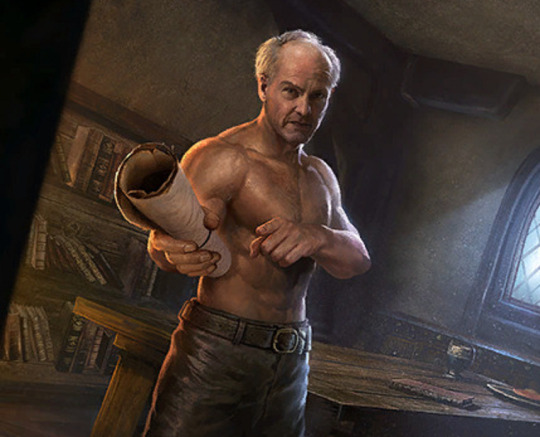
imperialism and science reading list
edited: by popular demand, now with much longer list of books
Of course Katherine McKittrick and Kathryn Yusoff.
People like Achille Mbembe, Pratik Chakrabarti, Rohan Deb Roy, Lizabeth Paravisini-Gebert, and Elizabeth Povinelli have written some “classics” and they track the history/historiography of US/European scientific institutions and their origins in extraction, plantations, race/slavery, etc.
Two articles I’d recommend as a summary/primer:
Zaheer Baber. “The Plants of Empire: Botanic Gardens, Colonial Power and Botanical Knowledge.” Journal of Contemporary Asia. May 2016.
Kathryn Yusoff. “The Inhumanities.” Annals of the American Association of Geographers. 2020.
Then probably:
Irene Peano, Marta Macedo, and Colette Le Petitcorps. “Introduction: Viewing Plantations at the Intersection of Political Ecologies and Multiple Space-Times.” Global Plantations in the Modern World: Sovereignties, Ecologies, Afterlives. 2023.
Sharae Deckard. “Paradise Discourse, Imperialism, and Globalization: Exploiting Eden.” 2010. (Chornological overview of development of knowledge/institutions in relationship with race, slavery, profit as European empires encountered new lands and peoples.)
Gregg Mitman. “Forgotten Paths of Empire: Ecology, Disease, and Commerce in the Making of Liberia’s Plantation Economy.” Environmental History. 2017, (Interesting case study. US corporations were building fruit plantations in Latin America and rubber plantations in West Africa during the 1920s. Medical doctors, researchers, and academics made a strong alliance these corporations to advance their careers and solidify their institutions. By 1914, the director of Harvard’s Department of Tropical Medicine was also simultaneously the director of the Laboratories of the Hospitals of the United Fruit Company, which infamously and brutally occupied Central America. This same Harvard doctor was also a shareholder in rubber plantations, and had a close personal relationship with the Firestone Tire and Rubber Company, which occupied West Africa.)
Elizabeth DeLoughrey. “Globalizing the Routes of Breadfruit and Other Bounties.” 2008. (Case study of how British wealth and industrial development built on botany. Examines Joseph Banks; Kew Gardens; breadfruit; British fear of labor revolts; and the simultaneous colonizing of the Caribbean and the South Pacific.)
Elizabeth DeLoughrey. “Satellite Planetarity and the Ends of the Earth.” 2014. (Indigenous knowledge systems; “nuclear colonialism”; US empire in the Pacific; space/satellites; the twentieth and twenty-first centuries.)
Fahim Amir. “Cloudy Swords.” e-flux Journal #115, February 2021. (”Pest control”; termites; mosquitoes; fear of malaria and other diseases during German colonization of Africa and US occupations of Panama and the wider Caribbean; origins of some US institutions and the evolution of these institutions into colonial, nationalist, and then NGO forms over twentieth century.)
Some of the earlier generalist classic books that explicitly looked at science as a weapon of empires:
Schiebinger’s Plants and Empire: Colonial Bioprospecting in the Atlantic World; Delbourgo’s and Dew’s Science and Empire in the Atlantic World; the anthology Colonial Botany: Science, Commerce, and Politics in the Early Modern World; Canzares-Esquerra’s Nature, Empire, and Nation: Explorations of the History of Science in the Iberian World.
One of the quintessential case studies of science in the service of empire is the British pursuit of quinine and the inoculation of their soldiers and colonial administrators to safeguard against malaria in Africa, India, and Southeast Asia at the height of their power. But there are so many other exemplary cases: Britain trying to domesticate and transplant breadfruit from the South Pacific to the Caribbean to feed laborers to prevent slave uprisings during the age of the Haitian Revolution. British colonial administrators smuggling knowledge of tea cultivation out of China in order to set up tea plantations in Assam. Eugenics, race science, biological essentialism, etc. in the early twentieth century. With my interests, my little corner of exposure/experience has to do mostly with conceptions of space/place; interspecies/multispecies relationships; borderlands and frontiers; Caribbean; Latin America; islands. So, a lot of these recs are focused there. But someone else would have better recs, especially depending on your interests. For example, Chakrabarti writes about history of medicine/healthcare. Paravisini-Gebert about extinction and Caribbean relationship to animals/landscape. Deb Roy focuses on insects and colonial administration in South Asia. Some scholars focus on the historiography and chronological trajectory of “modernity” or “botany” or “universities/academia,”, while some focus on Early Modern Spain or Victorian Britain or twentieth-century United States by region. With so much to cover, that’s why I’d recommend the articles above, since they’re kinda like overviews.Generally I read more from articles, essays, and anthologies, rather than full-length books.
Some other nice articles:
(On my blog, I’ve got excerpts from all of these articles/essays, if you want to search for or read them.)
Katherine McKittrick. “Dear April: The Aesthetics of Black Miscellanea.” Antipode. First published September 2021.
Katherine McKittrick. “Plantation Futures.” Small Axe. 2013.
Antonio Lafuente and Nuria Valverde. “Linnaean Botany and Spanish Imperial Biopolitics.” A chapter in: Colonial Botany: Science, Commerce, and Politics in the Early Modern World. 2004.
Kathleen Susan Murphy. “A Slaving Surgeon’s Collection: The Pursuit of Natural History through the British Slave Trade to Spanish America.” 2019. And also: “The Slave Trade and Natural Science.” In: Oxford Bibliographies in Atlantic History. 2016.
Timothy J. Yamamura. “Fictions of Science, American Orientalism, and the Alien/Asian of Percival Lowell.” 2017.
Elizabeth Bentley. “Between Extinction and Dispossession: A Rhetorical Historiography of the Last Palestinian Crocodile (1870-1935).” 2021.
Pratik Chakrabarti. “Gondwana and the Politics of Deep Past.” Past & Present 242:1. 2019.
Jonathan Saha. “Colonizing elephants: animal agency, undead capital and imperial science in British Burma.” BJHS Themes. British Society for the History of Science. 2017.
Zoe Chadwick. “Perilous plants, botanical monsters, and (reverse) imperialism in fin-de-siecle literature.” The Victorianist: BAVS Postgraduates. 2017.
Dante Furioso: “Sanitary Imperialism.” Jeremy Lee Wolin: “The Finest Immigration Station in the World.” Serubiri Moses. “A Useful Landscape.” Andrew Herscher and Ana Maria Leon. “At the Border of Decolonization.” All from e-flux.
William Voinot-Baron. “Inescapable Temporalities: Chinook Salmon and the Non-Sovereignty of Co-Management in Southwest Alaska.” 2019.
Rohan Deb Roy. “White ants, empire, and entomo-politics in South Asia.” The Historical Journal. 2 October 2019.
Rohan Deb Roy. “Introduction: Nonhuman Empires.” Comparative Studies of South Asia, Africa and the Middle East 35 (1). May 2015.
Lawrence H. Kessler. “Entomology and Empire: Settler Colonial Science and the Campaign for Hawaiian Annexation.” Arcadia (Spring 2017).
Sasha Litvintseva and Beny Wagner. “Monster as Medium: Experiments in Perception in Early Modern Science and Film.” e-flux. March 2021.
Lesley Green. “The Changing of the Gods of Reason: Cecil John Rhodes, Karoo Fracking, and the Decolonizing of the Anthropocene.” e-flux Journal Issue #65. May 2015.
Martin Mahony. “The Enemy is Nature: Military Machines and Technological Bricolage in Britain’s ‘Great Agricultural Experiment.’“ Environment and Society Portal, Arcadia. Spring 2021.
Anna Boswell. “Anamorphic Ecology, or the Return of the Possum.” 2018. And; “Climates of Change: A Tuatara’s-Eye View.”2020. And: “Settler Sanctuaries and the Stoat-Free State." 2017.
Katherine Arnold. “Hydnora Africana: The ‘Hieroglyphic Key’ to Plant Parasitism.” Journal of the History of Ideas - JHI Blog - Dispatches from the Archives. 21 July 2021.
Helen F. Wilson. “Contact zones: Multispecies scholarship through Imperial Eyes.” Environment and Planning. July 2019.
Tom Brooking and Eric Pawson. “Silences of Grass: Retrieving the Role of Pasture Plants in the Development of New Zealand and the British Empire.” The Journal of Imperial and Commonwealth History. August 2007.
Kirsten Greer. “Zoogeography and imperial defence: Tracing the contours of the Neactic region in the temperate North Atlantic, 1838-1880s.” Geoforum Volume 65. October 2015. And: “Geopolitics and the Avian Imperial Archive: The Zoogeography of Region-Making in the Nineteenth-Century British Mediterranean.” Annals of the Association of American Geographers. 2013,
Marco Chivalan Carrillo and Silvia Posocco. “Against Extraction in Guatemala: Multispecies Strategies in Vampiric Times.” International Journal of Postcolonial Studies. April 2020.
Laura Rademaker. “60,000 years is not forever: ‘time revolutions’ and Indigenous pasts.” Postcolonial Studies. September 2021.
Paulo Tavares. “The Geological Imperative: On the Political Ecology of the Amazon’s Deep History.” Architecture in the Anthropocene. Edited by Etienne Turpin. 2013.
Kathryn Yusoff. “Geologic Realism: On the Beach of Geologic Time.” Social Text. 2019. And: “The Anthropocene and Geographies of Geopower.” Handbook on the Geographies of Power. 2018. And: “Climates of sight: Mistaken visbilities, mirages and ‘seeing beyond’ in Antarctica.” In: High Places: Cultural Geographies of Mountains, Ice and Science. 2008. And:“Geosocial Formations and the Anthropocene.” 2017. And: “An Interview with Elizabeth Grosz: Geopower, Inhumanism and the Biopolitical.” 2017.
Mara Dicenta. “The Beavercene: Eradication and Settler-Colonialism in Tierra del Fuego.” Arcadia. Spring 2020.
And then here are some books:
Africa as a Living Laboratory: Empire, Development, and the Problem of Scientific Knowledge, 1870-1950 (Helen Tilley, 2011); Plants and Empire: Colonial Bioprospecting in the Atlantic World (Londa Schiebinger, 2004)
Red Coats and Wild Birds: How Military Ornithologists and Migrant Birds Shaped Empire (Kirsten A. Greer); The Empirical Empire: Spanish Colonial Rule and the Politics of Knowledge (Arndt Brendecke, 2016); Medicine and Empire, 1600-1960 (Pratik Chakrabarti, 2014)
Anglo-European Science and the Rhetoric of Empire: Malaria, Opium, and British Rule in India, 1756-1895 (Paul Winther); Peoples on Parade: Exhibitions, Empire, and Anthropology in Nineteenth-Century Britain (Sadiah Qureshi, 2011); Unfreezing the Arctic: Science, Colonialism, and the Transformation of Inuit Lands (Andrew Stuhl)
Fugitive Science: Empiricism and Freedom in Early African American Culture (Britt Rusert, 2017); Pasteur’s Empire: Bacteriology and Politics in France, Its Colonies, and the World (Aro Velmet, 2022); Colonizing Animals: Interspecies Empire in Myanmar (Jonathan Saha)
The Nature of German Imperialism: Conservation and the Politics of Wildlife in Colonial East Africa (Bernhard Gissibl, 2019); Curious Encounters: Voyaging, Collecting, and Making Knowledge in the Long Eighteenth Century (Edited by Adriana Craciun and Mary Terrall, 2019)
Frontiers of Science: Imperialism and Natural Knowledge in the Gulf South Borderlands, 1500-1850 (Cameron B. Strang); The Ends of Paradise: Race, Extraction, and the Struggle for Black Life in Honduras (Chirstopher A. Loperena, 2022); Mining Language: Racial Thinking, Indigenous Knowledge, and Colonial Metallurgy in the Early Modern Iberian World (Allison Bigelow, 2020); The Herds Shot Round the World: Native Breeds and the British Empire, 1800-1900 (Rebecca J.H. Woods); American Tropics: The Caribbean Roots of Biodiversity Science (Megan Raby, 2017); Producing Mayaland: Colonial Legacies, Urbanization, and the Unfolding of Global Capitalism (Claudia Fonseca Alfaro, 2023)
Domingos Alvares, African Healing, and the Intellectual History of the Atlantic World (James Sweet, 2011); A Temperate Empire: Making Climate Change in Early America (Anya Zilberstein, 2016); Educating the Empire: American Teachers and Contested Colonization in the Philippines (Sarah Steinbock-Pratt, 2019); Soundings and Crossings: Doing Science at Sea, 1800-1970 (Edited by Anderson, Rozwadowski, et al, 2016)
Possessing Polynesians: The Science of Settler Colonial Whiteness in Hawai’i and Oceania (Maile Arvin); Overcoming Niagara: Canals, Commerce, and Tourism in the Niagara-Great Lakes Borderland Region, 1792-1837 (Janet Dorothy Larkin, 2018); A Great and Rising Nation: Naval Exploration and Global Empire in the Early US Republic (Michael A. Verney, 2022); In the Museum of Man: Race, Anthropology, and Empire in France, 1850-1960 (Alice Conklin, 2013)
Visible Empire: Botanical Expeditions and Visual Culture in the Hispanic Enlightenment (Daniela Cleichmar, 2012); Tea Environments and Plantation Culture: Imperial Disarray in Eastern India (Arnab Dey, 2022); Drugs on the Page: Pharmacopoeias and Healing Knowledge in the Early Modern Atlantic World (Edited by Crawford and Gabriel, 2019)
Cooling the Tropics: Ice, Indigeneity, and Hawaiian Refreshment (Hi’ilei Kawehipuaakahaopulani Hobart, 2022); In Asian Waters: Oceanic Worlds from Yemen to Yokkohama (Eric Tagliacozzo); Yellow Fever, Race, and Ecology in Nineteenth-Century New Orleans (Urmi Engineer Willoughby, 2017); Turning Land into Capital: Development and Dispossession in the Mekong Region (Edited by Hirsch, et al, 2022); Mining the Borderlands: Industry, Capital, and the Emergence of Engineers in the Southwest Territories, 1855-1910 (Sarah E.M. Grossman, 2018)
Knowing Manchuria: Environments, the Senses, and Natural Knowledge on an Asian Borderland (Ruth Rogaski); Colonial Fantasies, Imperial Realities: Race Science and the Making of Polishness on the Fringes of the German Empire, 1840-1920 (Lenny A. Urena Valerio); Against the Map: The Politics of Geography in Eighteenth-Century Britain (Adam Sills, 2021)
Under Osman’s Tree: The Ottoman Empire, Egypt, and Environmental History (Alan Mikhail, 2017); Imperial Nature: Joseph Hooker and the Practices of Victorian Science (Jim Endersby); Proving Grounds: Militarized Landscapes, Weapons Testing, and the Environmental Impact of U.S. Bases (Edited by Edwin Martini, 2015)
Colonial Botany: Science, Commerce, and Politics in the Early Modern World (Multiple authors, 2007); Space in the Tropics: From Convicts to Rockets in French Guiana (Peter Redfield); Seeds of Empire: Cotton, Slavery, and the Transformation of the Texas Borderlands, 1800-1850 (Andrew Togert, 2015); Dust Bowls of Empire: Imperialism, Environmental Politics, and the Injustice of ‘Green’ Capitalism (Hannah Holleman, 2016); Postnormal Conservation: Botanic Gardens and the Reordering of Biodiversity Governance (Katja Grotzner Neves, 2019)
Botanical Entanglements: Women, Natural Science, and the Arts in Eighteenth-Century England (Anna K. Sagal, 2022); The Platypus and the Mermaid and Other Figments of the Classifying Imagination (Harriet Ritvo); Rubber and the Making of Vietnam: An Ecological History, 1897-1975 (Michitake Aso); A Billion Black Anthropocenes or None (Kathryn Yusoff, 2018); Staple Security: Bread and Wheat in Egypt (Jessica Barnes, 2023); No Wood, No Kingdom: Political Ecology in the English Atlantic (Keith Pluymers); Planting Empire, Cultivating Subjects: British Malaya, 1768-1941 (Lynn Hollen Lees, 2017); Fish, Law, and Colonialism: The Legal Capture of Salmon in British Columbia (Douglas C. Harris, 2001); Everywhen: Australia and the Language of Deep Time (Edited by Ann McGrath, Laura Rademaker, and Jakelin Troy); Subject Matter: Technology, the Body, and Science on the Anglo-American Frontier, 1500-1676 (Joyce Chaplin, 2001)
American Lucifers: The Dark History of Artificial Light, 1750-1865 (Jeremy Zallen); Ruling Minds: Psychology in the British Empire (Erik Linstrum, 2016); Lakes and Empires in Macedonian History: Contesting the Water (James Pettifer and Mirancda Vickers, 2021); Inscriptions of Nature: Geology and the Naturalization of Antiquity (Pratik Chakrabarti); Seeds of Control: Japan’s Empire of Forestry in Colonial Korea (David Fedman)
Do Glaciers Listen?: Local Knowledge, Colonial Encounters, and Social Imagination (Julie Cruikshank); The Fishmeal Revolution: The Industrialization of the Humboldt Current Ecosystem (Kristin A. Wintersteen, 2021); The Earth on Show: Fossils and the Poetics of Popular Science, 1802-1856 (Ralph O’Connor); An Imperial Disaster: The Bengal Cyclone of 1876 (Benjamin Kingsbury, 2018); Geographies of City Science: Urban Life and Origin Debates in Late Victorian Dublin (Tanya O’Sullivan, 2019)
American Hegemony and the Postwar Reconstruction of Science in Europe (John Krige, 2006); Carnal Knowledge and Imperial Power: Race and the Intimate in Colonial Rule (Ann Laura Stoler, 2002); Rivers of the Sultan: The Tigris and Euphrates in the Ottoman Empire (Faisal H. Husain, 2021);
The Sanitation of Brazil: Nation, State, and Public Health, 1889-1930 (Gilberto Hochman, 2016); The Imperial Security State: British Colonial Knowledge and Empire-Building in Asia (James Hevia); Japan’s Empire of Birds: Aristocrats, Anglo-Americans, and Transwar Ornithology (Annika A. Culver, 2022)
Moral Ecology of a Forest: The Nature Industry and Maya Post-Conservation (Jose E. Martinez, 2021); Sound Relations: Native Ways of Doing Music History in Alaska (Jessica Bissette Perea, 2021); Citizens and Rulers of the World: The American Child and the Cartographic Pedagogies of Empire (Mashid Mayar); Anthropology and Antihumanism in Imperial Germany (Andrew Zimmerman, 2001)
The Botany of Empire in the Long Eighteenth Century (Multiple authors, 2016); The Nature of Slavery: Environment and Plantation Labor in the Anglo-Atlantic World (Katherine Johnston, 2022); Seeking the American Tropics: South Florida’s Early Naturalists (James A. Kushlan, 2020); The Postwar Origins of the Global Environment: How the United Nations Built Spaceship Earth (Perrin Selcer, 2018)
The Colonial Life of Pharmaceuticals: Medicines and Modernity in Vietnam (Laurence Monnais); Quinoa: Food Politics and Agrarian Life in the Andean Highlands (Linda J. Seligmann, 2023) ; Critical Animal Geographies: Politics, intersections and hierarchies in a multispecies world (Edited by Kathryn Gillespie and Rosemary-Claire Collard, 2017); Spawning Modern Fish: Transnational Comparison in the Making of Japanese Salmon (Heather Ann Swanson, 2022); Imperial Visions: Nationalist Imagination and Geographical Expansion in the Russian Far East, 1840-1865 (Mark Bassin, 2000); The Usufructuary Ethos: Power, Politics, and Environment in the Long Eighteenth Century (Erin Drew, 2022)
Intimate Eating: Racialized Spaces and Radical Futures (Anita Mannur, 2022); On the Frontiers of the Indian Ocean World: A History of Lake Tanganyika, 1830-1890 (Philip Gooding, 2022); All Things Harmless, Useful, and Ornamental: Environmental Transformation Through Species Acclimitization, from Colonial Australia to the World (Pete Minard, 2019)
Practical Matter: Newton’s Science in the Service of Industry and Empire, 1687-1851 (Margaret Jacob and Larry Stewart); Visions of Nature: How Landscape Photography Shaped Setller Colonialism (Jarrod Hore, 2022); Timber and Forestry in Qing China: Sustaining the Market (Meng Zhang, 2021); The World and All the Things upon It: Native Hawaiian Geographies of Exploration (David A. Chang);
Deep Cut: Science, Power, and the Unbuilt Interoceanic Canal (Christine Keiner); Writing the New World: The Politics of Natural History in the Early Spanish Empire (Mauro Jose Caraccioli); Two Years below the Horn: Operation Tabarin, Field Science, and Antarctic Sovereignty, 1944-1946 (Andrew Taylor, 2017); Mapping Water in Dominica: Enslavement and Environment under Colonialism (Mark W. Hauser, 2021)
To Master the Boundless Sea: The US Navy, the Marine Environment, and the Cartography of Empire (Jason Smith, 2018); Fir and Empire: The Transformation of Forests in Early Modern China (Ian Matthew Miller, 2020); Breeds of Empire: The ‘Invention’ of the Horse in Southeast Asia and Southern Africa 1500-1950 (Sandra Swart and Greg Bankoff, 2007)
Science on the Roof of the World: Empire and the Remaking of the Himalaya (Lachlan Fleetwood, 2022); Cattle Colonialism: An Environmental History of the Conquest of California and Hawai’i (John Ryan Fisher, 2017); Imperial Creatures: Humans and Other Animals in Colonial Singapore, 1819-1942 (Timothy P. Barnard, 2019)
An Ecology of Knowledges: Fear, Love, and Technoscience in Guatemalan Forest Conservation (Micha Rahder, 2020); Empire and Ecology in the Bengal Delta: The Making of Calcutta (Debjani Bhattacharyya, 2018); Imperial Bodies in London: Empire, Mobility, and the Making of British Medicine, 1880-1914 (Kristen Hussey, 2021)
Biotic Borders: Transpacific Plant and Insect Migration and the Rise of Anti-Asian Racism in America, 1890-1950 (Jeannie N. Shinozuka); Coral Empire: Underwater Oceans, Colonial Tropics, Visual Modernity (Ann Elias, 2019); Hunting Africa: British Sport, African Knowledge and the Nature of Empire (Angela Thompsell, 2015)
326 notes
·
View notes
Text


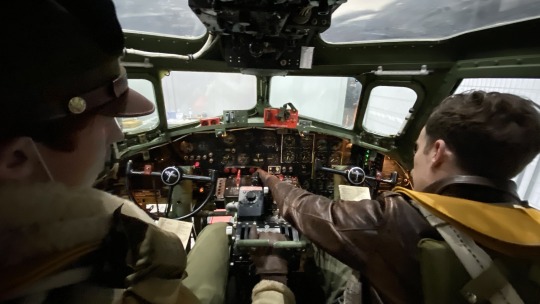

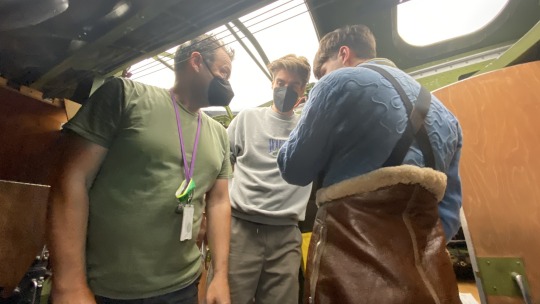

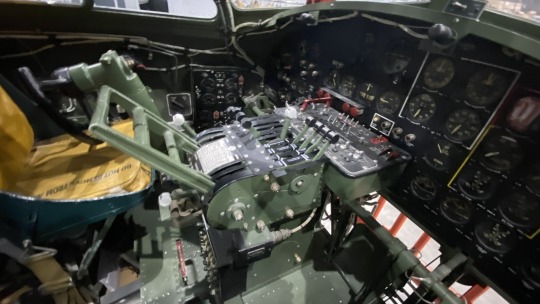




"Masters of the Air detail: Part 2-Dave Littleton
"[...] Dave is a lifelong WWII aviation enthusiast who has worked on a lot of other films in the past. He has a passion for the B-17 that goes back to his childhood. So much so that he has built a super accurate cockpit, from scratch over 20+ years, using a lot of original parts and equipment. The rest he made by hand. He brought his cockpit to the studio, and it was wonderful for sure.
"Dave worked pre-production, hand in hand with BGI, the company that made a lot, if not most, of the B-17 props and the two full-size aircraft. He gave them the drawings, photos and answered their questions. I think he was instrumental in the success of so many aspects of MOTA.
"I was asked to come over to teach the aircrew how to look like they could pilot, navigate, drop bombs, shoot guns, radio work etc., which ended up being a lot more than that. Dave let us use his cockpit for the flight training and top turret gunner/engineer duties.
"The pilots and engineers went through initial training in Dave’s cockpit and then we would rehearse for the specific scenes.
"I thought that some of the actors might have had some sort of prior knowledge of flying from gaming or flight simulators, but this was not the case. None of them had any concept of flying which was perfectly okay. I had to sit them down in a chair and teach them the very basics of the flight controls and how they are used. Grabbing an imaginary control wheel and had their feet on imaginary rudder pedals. Making sure they used the rudders first and then aileron as you would in a heavy tail wheel aircraft.
"We then progressed into Dave’s cockpit to teach them the myriad of engine controls and their basic function. Later when we had a specific scene, we would go through the procedures whether it be takeoff, landing, engine shutdown etc. Just having them know where to look on the panel for power changes, checklist, formation flying etc. worked out well. The “kids” did a fantastic job and it shows in the episodes.
"The biggest item to try and get across to the actors was being a cohesive flight crew. Remember that the original guys had been flying together for a while and that was an important aspect of their training for the filming. There is nothing sweeter than flying with someone for a while where you get to know each other and anticipate what the other needs before he asks for it. We trained the pilot, copilot and engineer together for takeoff so the pilot would be pushing the throttles with the copilot backing him up, doing the fine tuning, and the engineer in between them doing his part too. The copilot or flight engineer reaching down for the prop controls during power changes as this would differ from one flight crew to another. Same with running the checklist as the engineer and even crew in the back are participating over the interphone. And these details made the final cut and it looked great. Okay, I may be biased…
"Dave’s cockpit was so very helpful for the training because it was on the floor and was easily accessible. The main cockpit used for filming was on a gimbal 20 feet in the air! With Dave’s cockpit, I could lean in from a side window and instruct with all three crew in place. The various directors could also come up to each side and see and direct how they wanted the scene to go. It would give them ideas on camera angles to set up.
"The other aspect of Dave’s wonderful cockpit was its authenticity and detail. He used so many original parts that it is as accurate as could possibly be. Dave wanted it used as much as possible but frankly was a bit shy about this. Not having ever been known for being shy, I really wanted it used for as many close ups as possible and pushed for this. As a result, you can see Dave’s awesome detailed handiwork in MOTA especially in the close-up scenes showing the magneto switches, electrical, primer use and so much more.
"Dave and I were basically the only two on set who had extensive knowledge of WWII aviation and B-17 information. We were constantly being asked questions and were helping lots of different departments. He and I split up the advising since there were several units filming at the same time. We were both out in the field to start mostly at Abingdon where the full size BGI aircraft were. When the volume or studio started ramping up, I stayed there training and rehearsing while Dave continued the field work. We were trying our best to keep things realistic and authentic, but we were spread really thin.
"Dave took off a lot of time from his day job to do this project, as did I, but with the production over runs, COVID etc. he had to go back to work and sadly missed the last few months of filming. We sure missed Dave, especially out in the field, although he was always available by phone and still helped out as much as he could..." - (Taigh Ramey on Facebook)
#if y'all would prefer the huge chunk of text under a 'read more' lmk!#masters of the air#hbo war#behind the scenes#crew#david shields#austin butler#nate mann#callum turner#elliott ross#louis greatorex#anthony boyle#jonas moore#long post
57 notes
·
View notes
Text
Gundam 00 "Trust You" Diorama
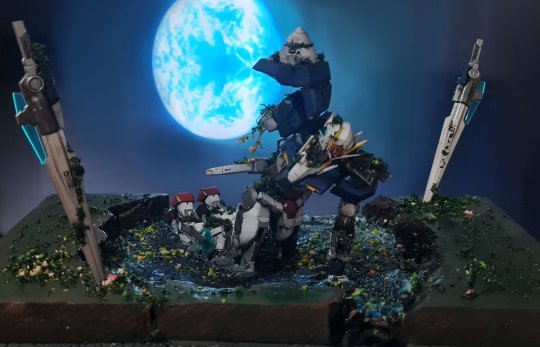



A little diorama I have idealized for a long time and I finally finished recently.
The base kit is MG 00 Raiser.
"Trust You", the 4th ending theme of Gundam 00, means a lot to me for many reasons - be it the lyrics that make me think of my relationship with Setsuna or the beautiful imagery. So I poured all my heart into this project.
Diorama progress stages and explanation under the cut
After sanding all pieces, I applied Mr. Surfacer primer. Gray for the light pieces (white and yellow) and black for everything else.
I built the whole kit in order to apply the highlight with the White Mr. Surfacer. This way I wouldn't accidentally mess up the shading position.
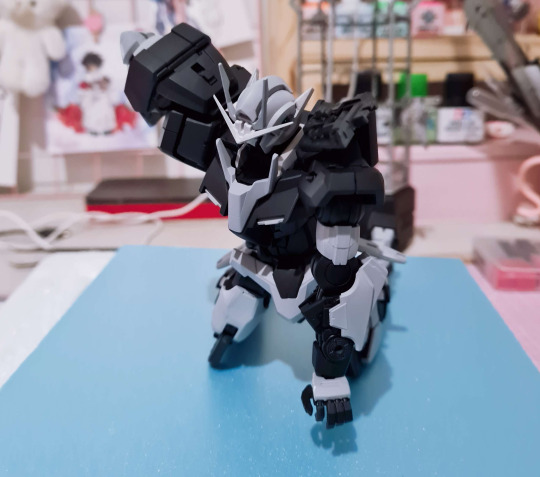
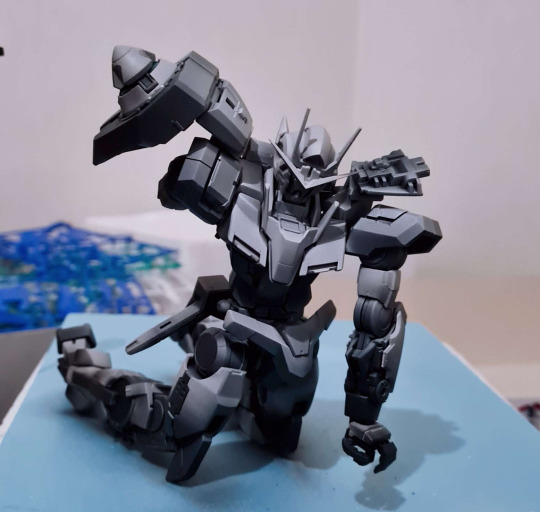
Then I unbuilt everything once again and painted with the normal 00 Gundam colors. Mostly Tamiya acrylics on airbrush. I applied a gloss varnish to seal the paint and start working on the weathering.
After everything was done, I applied Mr. Hobby Super Smooth flat top coat.
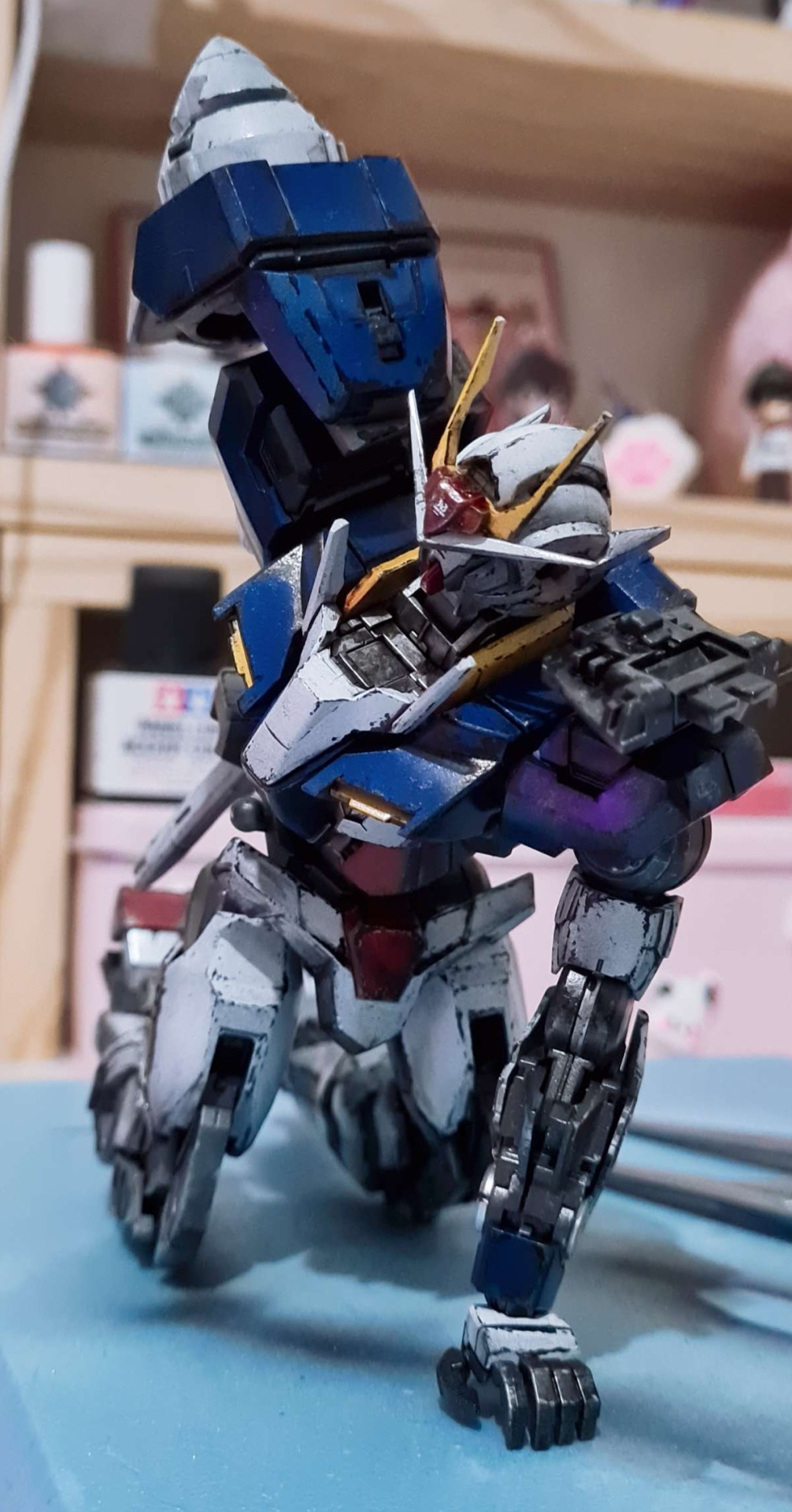
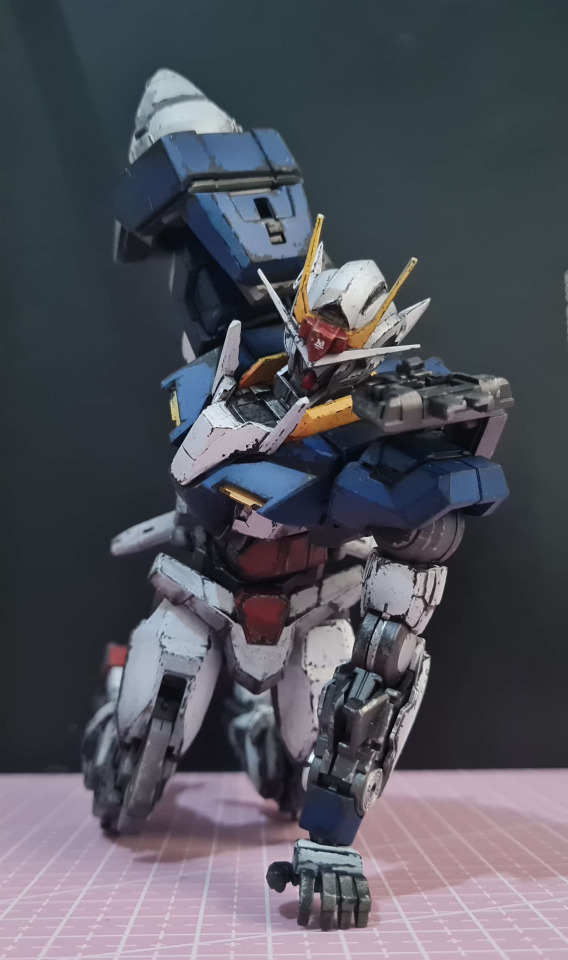
The diorama base was made out of styrofoam and painted with Tamiya acrylics using a brush.


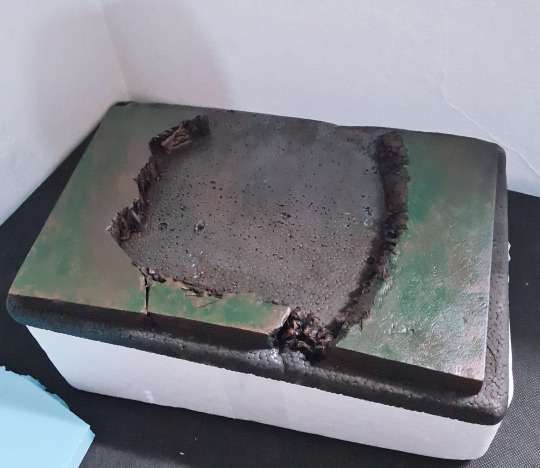
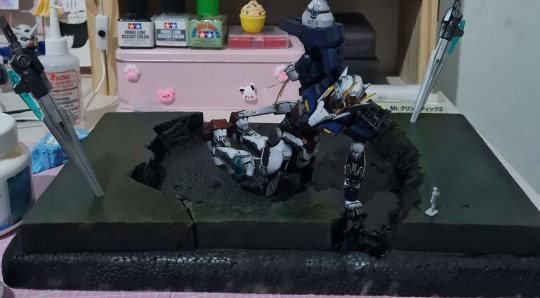
I got some diorama flowers from WJDG Model and carefully placed it on the base and on top of the gunpla using PVA glue.
Then I added the diorama water texture effect by Ammo Mig.
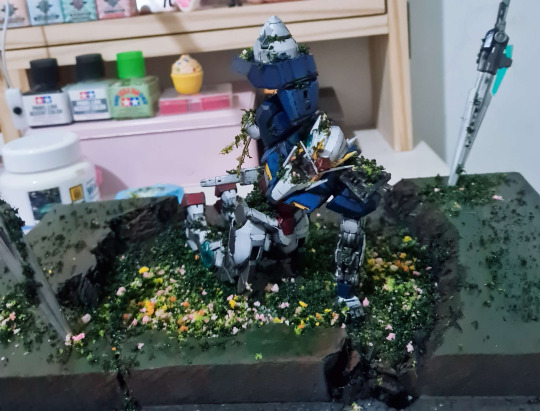
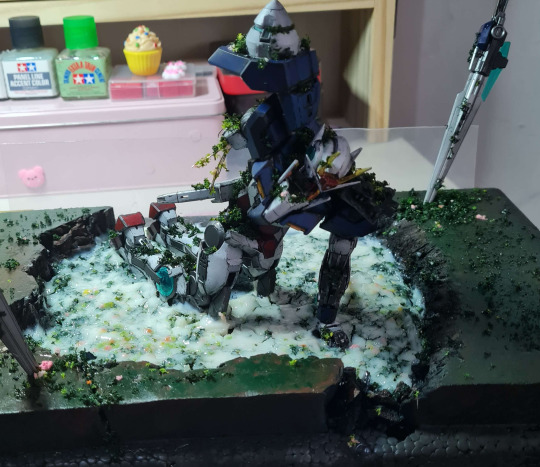
Painting the water with Tamiya Clear Blue, German Gray, and some white for the highlights.
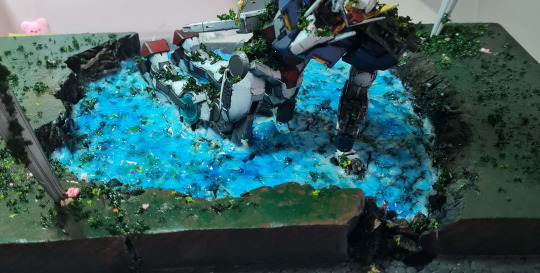
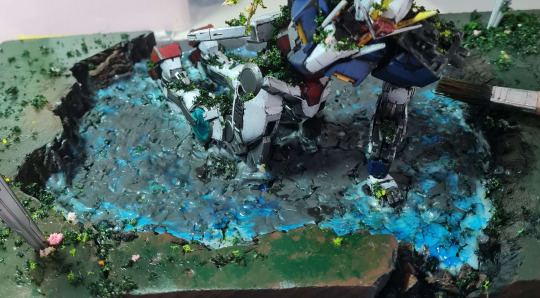
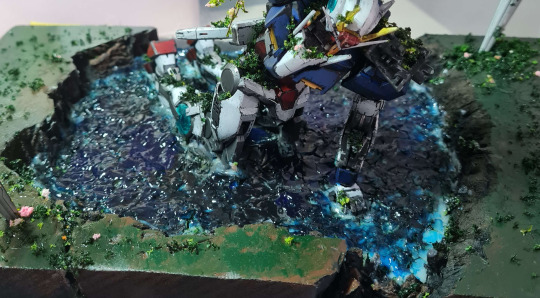
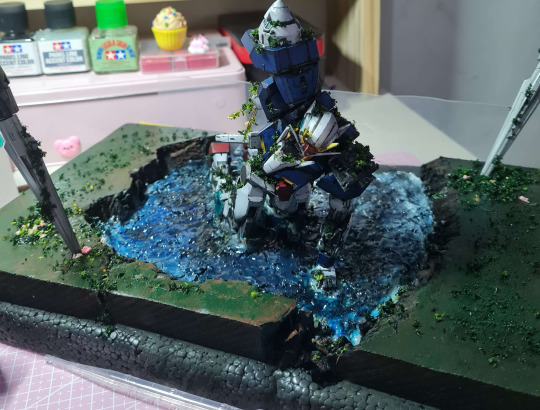
I know the whole diorama isn't really accurate for the original image, but I really wanted it to be Soran there. I find it especially meaningful that the ending has Soran all content appreciating the accomplishments of his adult self. If 00 Gundam is destroyed then it isn't needed anymore and peace is achieved. He gets to see for himself that flowers can indeed bloom in weapons. Good things came after his life of destruction.
But ok, I'd have to heavily modify one of the 1/100 Setsuna pilot figures.
I stole the pilot figure from MG Exia because I had a spare one. I didn't want to sacrifice the cozy and precious Setsuna in casual outfit that comes with MG 00 Raiser.
Sanded off some details. I made his jacket with Tamiya Putty. Glued the figure back together. Applied gray primer and wash.
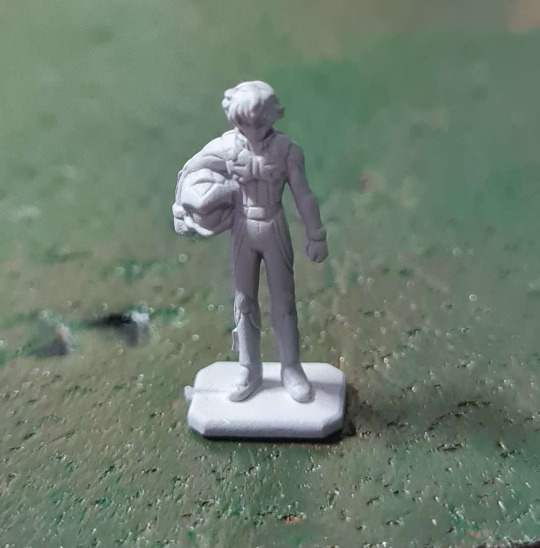
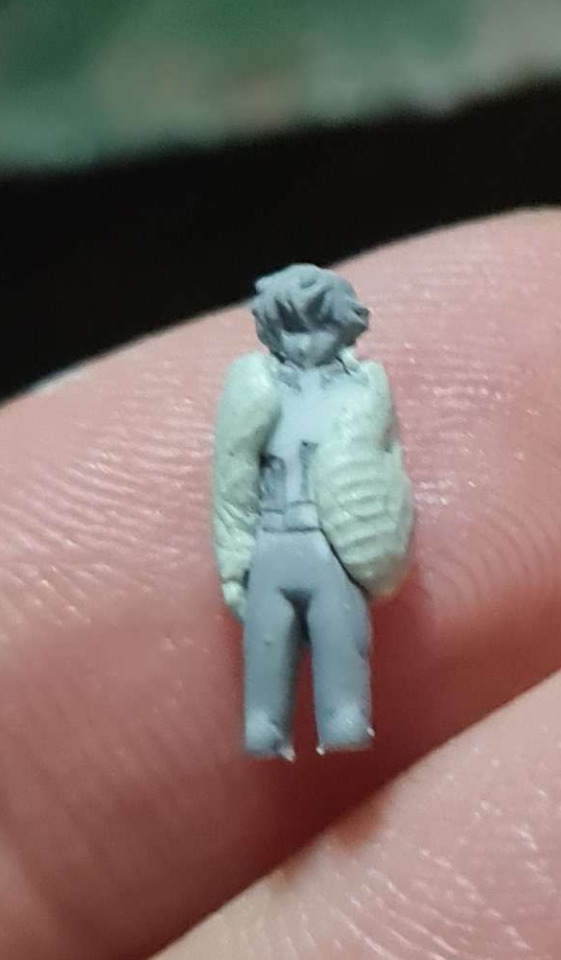
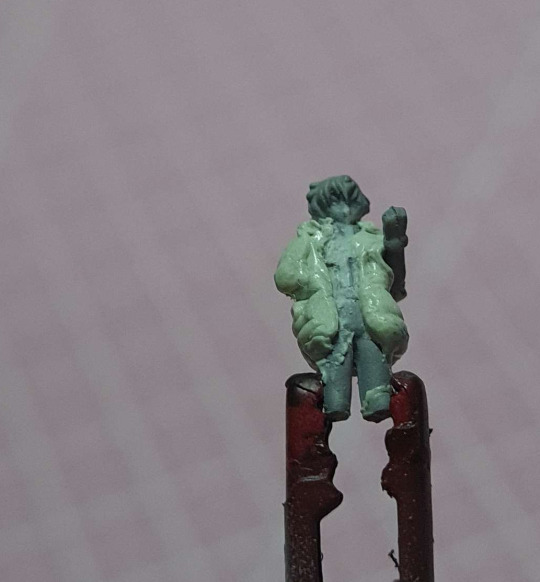
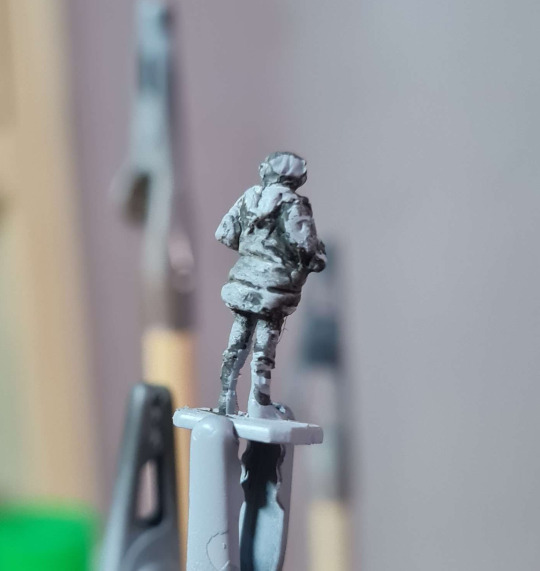
The Soran figure.


As a bonus, the painted casual outfit Setsuna.

The finished diorama.

Thanks for reading.
85 notes
·
View notes
Text
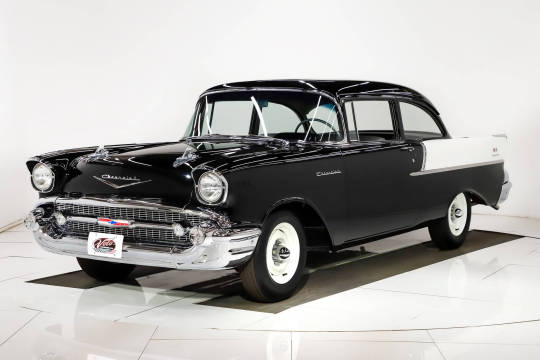
1957 Chevy
The Legendary “Black Widow” 1957 Chevy: A Piece of Racing History
When it comes to legendary cars, the 1957 Chevrolet, also known as the “Black Widow,” holds a special place in the hearts of car enthusiasts. However, few people know the intriguing story behind this iconic vehicle. In this article, we will take you on a journey through time and explore the fascinating history of the Black Widow.
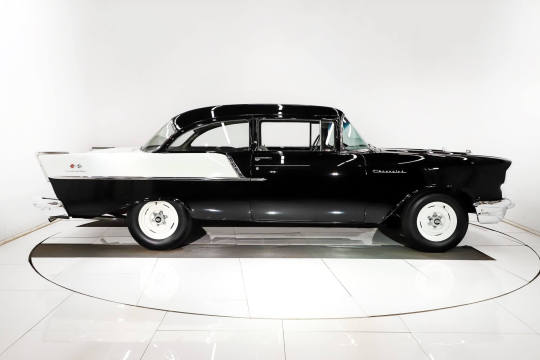
The Secret Support Behind the Scenes
In the 1950s, car manufacturers were prohibited from directly promoting racing. Nevertheless, behind closed doors, Chevrolet found a way to support the racing community. They collaborated with a company called SEDCO to build a limited number of race-ready 1957 Chevys. Only 18 of these incredible vehicles were ever produced.

Unleashing the Beast
To create the ultimate racing machine, Chevrolet started with the lightest model available, the no-frills 150 utility sedan. They then equipped these cars with high-performance drivelines that would leave their competitors in awe. The Black Widows proved to be astonishingly fast, setting records and securing multiple victories on the track.

Restoring the Legend
One particular Black Widow has undergone an extensive body-off-frame restoration, meticulously recreating its original glory. The attention to detail is impeccable, resulting in a pristine body that is arguably even better than when it first rolled off the factory floor.
Exquisite Exterior
Painted in the iconic Black Widow colors of Onyx Black and India Ivory, the exterior of this restored beauty is nothing short of breathtaking. Every panel is laser straight, and the gaps are precise. There isn’t a hint of rust or damage to be found. The flawless paint job has been polished to a mirror-like finish, allowing you to see your own reflection. It’s like holding history in your hands.
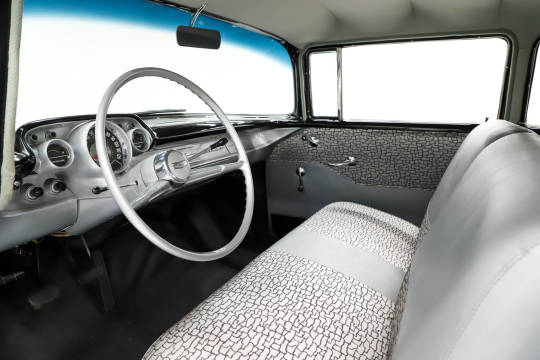
Interior Simplicity
Inside the Black Widow, you’ll find a minimalist design that emphasizes performance over luxury. There are no frills, not even a back seat! The rear windows are stationary, and amenities such as armrests, visors, and even a dome light are absent. However, this simplicity only adds to the car’s authenticity and racing pedigree.

Attention to Detail
No aspect of the Black Widow’s restoration has been overlooked, including the trunk compartment. Painted in glossy white, it exudes cleanliness and attention to detail. A reproduction mat, seat divider, and weatherstrip have been added to complete the authentic look. Even the spare tire matches the original style with its 6 lug pattern and reproduction Firestone tire.
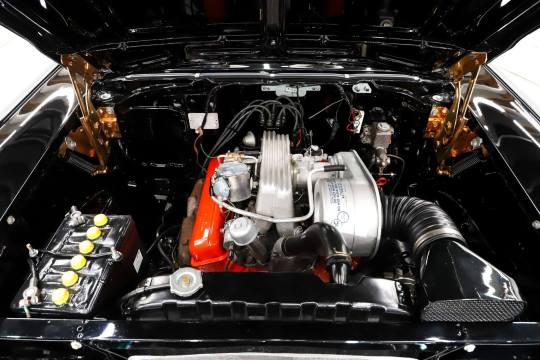
The Heart of a Champion
Under the hood lies a highly detailed engine compartment that exemplifies show-quality craftsmanship. The 283 cubic-inch V8 engine has been built to its original 283 horsepower specifications, complete with a correct factory fuel injection setup. Not only does it look stunning, but it also performs flawlessly. With a responsive throttle and a distinctive idle, this powerhouse truly embodies the spirit of a race car.
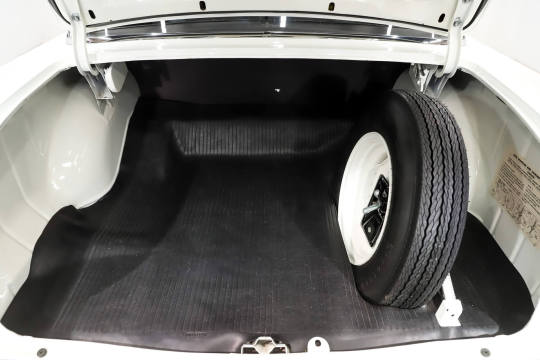
A Masterpiece Underneath
The detailed restoration extends to the underside of the car as well. The chassis has been meticulously prepped and painted in a smooth gloss black finish. Every component has been rebuilt, replaced, restored, and detailed to match the original specifications. The Black Widow features front and rear sway bars, as well as the unique duplication of two shocks at each rear wheel for enhanced performance.
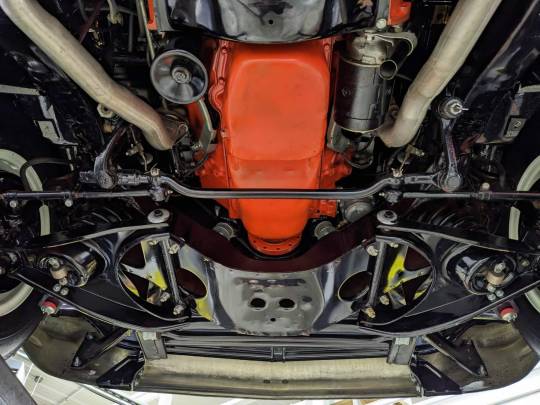
A True Muscle Car
With its completely rebuilt brake system, all-new fuel system, and Flowmaster dual exhaust, this Black Widow not only looks and sounds like a classic muscle car but also performs like one. The spotless Chevy Orange engine block, lower plug wire shielding, canister-type oil filter, restored starter, and dated 1957 transmission all contribute to creating an authentic driving experience. The floors, braces, and rockers have been meticulously restored to their original factory red oxide primer finish.
99 notes
·
View notes
Text
The struggle to Stop Cop City is not just a battle over the creation of a $90 million police urban warfare center. It's not just a fight to protect the 381 acres of forest land, known as one of the "four lungs" of Atlanta, currently under threat of destruction. It's not just a conflict over how the city invests the over $30 million it has pledged to the project, to be supplemented by at least $60 million in private funding.
The movement is all of those things. But even more fundamentally, the struggle to Stop Cop City is a battle for the future of Atlanta.
It's a struggle over who the city is for: the city's corporate and state ruling class actors who have demanded that Cop City be built, or the people of Atlanta who have consistently voiced their opposition and demanded a different vision for the city. It is a fight over who the city belongs to; over who Atlanta is run for and who it is run against; over who is welcome to live and enjoy life here, and who is expected to simply labor here for low wages and under constant surveillance.
In January 2023, Cop City claimed its first life when a joint task force of local and state police officers marched into the Weelaunee Forest and assassinated Tortuguita Terán, a 26-year-old queer, Indigenous-Venezuelan forest defender. The project has already claimed the lives of trees in the forest, as clear-cutting began in March 2023. Cop City has already stolen the freedom of 42 people who have been charged with domestic terrorism and dozens more who were violently arrested while protesting the project.
As the struggle to stop Cop City has gone national and international, it has also left many wondering: Given so much widespread opposition, why is the city of Atlanta so intent on building Cop City? And if they insist on building Cop City, why build it atop such precious forest land? And why now, when the plans were first proposed as early as 2017 and the city had previously committed to protecting and preserving the land in question?
Contribute to the Atlanta Solidarity Fund to support the legal defense of Forest Defenders facing domestic terrorism charges.
Learn more about the ongoing fight to #StopCopCity and Defend the Atlanta Forest.
228 notes
·
View notes
Text
The Villainous Paranoiac is Suing for Character Defamation
Vil’s agent is a competent woman.
There’s no way she would have kept her position if she wasn’t. A minor he may’ve been, but even when he was starting out, Vil Schoenheit knew better than to allow someone slothful or greedy to manage his talent and performances.
His father helped him weed out those burdened by these vices, even trusting his son’s judgement on those who tried to play on the long relationships his father had built with them, until Vil’s current agent was the last one left standing.
She was a protege of Vil’s father’s manager, one who already had experience managing older talent, but also a rather scrupulous set of morals concerning children.
Vil has always suspected this may have something to do with all the younger siblings and cousins she sometimes mentions. He’s not going to risk their professional relationship to confirm it though.
She calls him every morning to give him the rundown on his projects for the day, as well as any news that could be pertinent to him.
This morning, like many other mornings before it, she says, “You’re being scouted for several roles by a number of notable studios. Warui Bros. and Reynard Studios are still keeping the roles of the rival open—“
“Pass.” Vil states as he finishes daubing on his primer. “As I’ve said the last two times.”
“Well,” There’s the sound of nails tap-tap-tapping away on her tablet. “Akareiju Studios has a role they’ve requested you specifically for a new movie—!“
“With everything I’ve got on my plate?” He says dismissively. “Hardly. Send my—“
“You’d be the male lead.” She says.
Vil pauses for a moment, sponge hovering over his skin.
“It’s a movie adaptation of a light novel that’s been popular online lately,” She rattles off with her usual efficiency. “Lost Princess: Entangled with my Graceful Family. The premise is simple—Karatsumori Megami, a middle schooler mourning the death of her mother, discovers she is actually the kidnapped youngest daughter of a powerful family, and is whisked away to a life of luxury. Along the way she must adapt to the pressures of her new lifestyle, open up the hearts of her long lost siblings, befriend others at her new elite school, and thwart the bullying of her twisted, cruel stepsister, proving that she is worthy of her place in the family. The author of the novel has agreed to personally work on the screenplay alongside the producers.”
Vil is careful not to pull a face as he sweeps the foundation brush over his cheeks. Trite, as plots went, but that was what audiences enjoyed. Something uncomplicated for them to leave feeling satisfied as though the accomplishments of the fictional characters were their own.
“The role of the male lead in this film is filled by the female lead’s eldest brother.” She continues. “Gracey Enji, heir to the Gracey Corporation. Described as a princely, serious high schooler, burdened with the expectations of inheriting his father’s role as CEO and pushing aside his feelings to better protect the interests of his younger siblings from afar. He’s the one with the most faith in the female lead and does his best to help her out overtly and covertly, but doesn’t actually let his guard down until she recognizes his efforts and vows to support him.”
Vil tilts his head to the side, considering his own face.
Not this look, certainly, it’s too glamorous, too Vil Schoenheit.
But some more subdued makeup colors, while still tinted to enhance his natural features, a severe, almost-too-finely-tailored cut to his clothes, maybe a pair of glasses to emphasize the image of a hard-working professional…
Yes, he could see himself donning the mantle of “Gracey Enji” well.
But there’s still one quibble that needs to be dealt with before he can get too invested.
“Who else will be part of the cast?” His attempts to make the question sound light and careless fall slightly flat. “Anyone I know?”
She hems and haws, the clicking of her fingers flying over her tablet screen audible through the phone.
“Neige LeBlanche has been approached,” His agent says. “For a brief cameo during the funeral scene as the heroine’s childhood friend.”
A slow smirk spreads over Vil’s face.
“Send me the script. I’ll have a read-through.”
***
Idia’s been over the hype about LoPri since before it even got off the ground.
He heard about it through one of the threads he frequents on Dreddit, a recommendation from a well-known user whose opinion he’s kind wishy-washy on.
He tried it, found the writing bland, the characterization muddy yet restrictive, and really couldn’t vibe with the undertones of “nuclear family by blood is the best and only real family, any kids born outside of a conventional marriage are inherently thieving irredeemable scumbags”.
What kind of message is that in this day and age?? Even the gods had more liberated family relations than that. Idia will be the first to burn the world down for Ortho, but this depiction of siblings kind of pisses him off, a tiny bit.
Unfortunately, even though he’s written it off as barely-above-garbage-tier, all the normies online have jumped on the hype train to sing its praises.
He’d usually just avoid the fandom, block and move on, but it’s like a fungus. It keeps popping up, even in places that should be safe! Places that should be sacred!
MrLeotaGracey: how can you not read LoPri
MrLeotaGracey: were you born in a barn???
cLoThO115: ???
MrLeotaGracey: smh
MrLeotaGracey: leota-chan and megami-chan are the most beautiful in existence
littollethegurl: no one was talking about lopri tho??
MrLeotaGracey: literally actual goddesses
MrLeotaGracey: if premo has any brains theyll do a tribute for LoPri
MrLeotaGracey: its just common sense for a dying idol group like this lol
PreMo5Evrr: dude wtf
Places like the message board for Precipice Moirai!!
Idia sighs despondently.
What is the world coming to, that stans like this can come into a nice chat like this and begin trash talking like they own the place? True, this guy is more virulent than the average fan, but the fact that he can’t read the atmosphere is just depressing.
And some users are getting triggered, which will lead to them getting banned unless someone does something.
Gloomurai: lol imagine god defending a ln thats the embodiment of mid
Gloomurai: imo cant relate
MrLeotaGracey: kys
MrLeotaGracey: fucking virgin whore
MrLeotaGracey: cringe loser cunts who cant understand how amazing LoPri is dont deserve rights
And any second now…
*MrLeotaGracey was banned by Mod Rougelike105*
“Another thread saved. Thank you for your services, Mod-sshi.” Sure they won’t be able to see the little salute he’s giving them, but he’s in his room! There’s no one to judge him here.
Idia stretches with a sigh. It’s not much, but whacking LoPri trolls is honest work.
Ah, Muscle Red’s signed on!
Idia eagerly turns his mind to much more welcome matters, like smashing mobs, defeating bosses, and collecting loot with his best friend online.
***
Bella DeNiâmerée is a tolerable enough writer, though her penchant for constant similes leaves something to be desired.
Vil’s just glad the other screenwriters have toned down the worst of her literary foibles.
The rest of the cast and crew are pleasant, professional, and enjoyable to work with. There are a few roles that haven’t been filled yet—the kind elder sister, one or two of the heroine’s quirky friends, the villainess—but overall read-throughs have been productive and helped him gain a better understanding of the role he is to play.
And he is the male lead. Someone who will stand in the spotlight all the way to the end, a proud protector of this happy little family.
Great Seven, what an intoxicating feeling it is.
He’s read source material a few times by now, to understand the odd, tech-punk world that the story is based in.
It seems like it’s almost a carbon copy of Twisted Wonderland, but without the magic. Some of the terminology, like “Instagram”, “Siri”, or “motorcycle” is a little confusing, but overall it’s easy to understand his character’s motivations.
Maybe it’s because of however many times he’s been made to take up the role himself, but Vil seems incapable of not feeling…something for the villainess.
And yes, more often than not that something is exasperation or disappointment, but the point still stands.
A bastard child singled out from the others for her resemblance to her mother, the kidnapper who’d been raising the heroine as her own. Constantly striving to be recognized, to outdo the legitimate children through any means, returning their ire with blunt, cutting barbs.
And with the arrival of the heroine, the villainess seeks to oust the one aiming to usurp her place with a tenacity that is almost reminiscent of the Beautiful Queen’s own.
And yet she resorts to such ugly means to accomplish her end—bullying, cheating, even arranging for the heroine to be kidnapped! Of course, all this results in is her getting exposed at the heroine’s middle school graduation, rejecting her forgiveness and stomping off to disownment in defeat.
Vil despairs of her choices, even as he privately sympathizes with her motives.
Really, if Gracey “Yuu” Fuyuhime has just focused on proving her suitability over her uncultured sister rather than trying to drag her down out of fear, she would still be an uncontested member of the family. The levels she let herself sink to, those were her downfall.
Vil himself certainly would never fall to those depths.
Still, the new school year will start soon. Vil’s third year at Night Raven College, his last year as dorm head.
He’s going to do his upmost to ensure it’s one that everybody will remember and recognize him for.
***
There’s some commotion going on at the entrance ceremony.
Idia watches the feed from his tablet with some vague interest. One of the firsties has been outed by the mirror as having no magic in their soul, and now the familiar they brought along has set Kalim-sshi on fire.
Boy, is he glad he’s not there in person. Fs in chat for Kalim-sshi.
Still, he thinks as his fingers fly over his keyboard, his tablet taking a picture of the trouble-making first year and setting up an image search. It’d be troublesome if some magicless scrub tried to wrangle a monster to sneak in to orientation, hoping they could coast by to get in to NRC.
Still, a background check and confirmation of their status emailed to the headmaster should clean the situation up.
Though, isn’t it too much that he has to do all this for the headmaster? He really needs some kind of compensation. Perhaps an exemption from all of Vargus’ classes? Extra budget for Ignihyde? Maybe even some new specs for Ortho—!
A jingle erupts from Idia’s speakers. A match!
He chuckles to himself as he taps on the link his search has brought up. Honestly, if someone was going to break in to NRC, they should know better than to leave traces of themself all over the net, like some cheesy villain—
The image that has popped up is an illustration from a light novel. The closeup of a face filled with resentment and distrust, the kind of expression to send shivers down anyone’s spine. Overgrown bangs casting the eyes in shadow for that extra bit of menace.
The header at the top of the screen proclaims this image to be page 39 of Lost Princess. The introduction of the villainess.
Eh?
Eh??
***
The first year with the out of control familiar is shouting at Crowley.
“—and, as I’ve been trying to tell you, I do not want to be here. I don’t know who you are. I don’t know where I am. And honestly?! I’ve half a mind to press charges against you and your sham of an institution for abduction of a minor!!”
Crowley squawks some insulted response as Vil rolls his eyes. Honestly, who did this magicless potato think they were?
Even if they did have a vaguely familiar face, it’s disappointing to see they’re ignorant of the best school in Twisted Wonderland. Though, maybe this dearth of knowledge is why they thought bringing a familiar they couldn’t control to Night Raven College was a good idea.
“Pomefiore, this way.” He calls. “Rook, if you could take the lead?”
He needs to keep an eye on that poison apple who’s now going to be under his care. Make sure he doesn’t do anything foolish, like try to escape.
As he glances behind him, he can see the headmaster and the magicless potato asking something else of the Dark Mirror. The potato is growing more and more agitated.
Oh well. It’s hardly his concern. He turns to follow—
“Kyoto? Tokyo?! Japan?! Do those mean nothing to you?!”
Vil feels himself stop despite his every intention.
He stares at the teenager who’s thrown their hood back, desperation in every inch of their frame.
The teenager who is the spitting image of the villainess in the light novel he’s the lead in the movie of.
Who has just name dropped the fantasy land said light novel takes place in.
What the fuck.
#twisted wonderland#twst#vil schoenheit#idia shroud#twisted wonderland yuu#twst yuu#villainous paranoiac yuu#vil & idia in reverse isekai land#gracey fuyuhime#gracey leota#gracey enji#gracey megami#karatsumori megami
81 notes
·
View notes
Text
3.11 - Council Estates and the Right To Buy
In 3.11, we saw Jamie go home to his mum’s, and we learned that she still lives in the council house that Jamie grew up in. This has interesting implications and possibly negative ones if construed the wrong way. In the Subjectify articles, we've already discussed those implications, because it's something I've been concerned about since we first saw the trailer shot of Jamie's childhood bedroom. I knew even then that the story beat would have to be about throwing back to the Roy poster - that's why they had to keep Georgie in the house Jamie grew up in, rather than have her in a new house elsewhere. It was a choice made specifically so Roy could see the poster.
But in making sure that could happen, it leaves us with the unfortunate framing that Jamie didn't buy his mum a house when he got rich, and "buying your mum a house" is basically the first thing a working class footballer like him would do with his money. It's a really standard baseline. I have been nervously obsessing about Ted Lasso accidentally implying that Jamie wouldn’t have done that, for months now. I had already decided, before the episode aired, that if they did not clarify either way, I would have to assume that she did not want to leave the place she lived, and that rather than a new house, Jamie had bought her their old house on the Right To Buy, a government scheme introduced in the 1980s that allows most council tenants to buy their council home at a discount. (I do have issues with this policy generally, and the impact it had on the amount of council housing available, but that’s not for now.)
There is sort of a level of visual evidence for this - the inside of his mum’s house is really well maintained and clearly full of pretty expensive furniture and items. They definitely own it, and having now met her, gotten her vibe and seen the kind of house it is, it makes a huge amount of sense to me that she stayed there. It might have felt different if we saw a different KIND of council home, but in this specific situation, it tracks.
There’s a bit in my primer about this, but in the UK, council housing comes in a lot of different shapes and sizes. Some of them will be flats in tower blocks (like the one Roy points to from the Westway sports pitch in 2.05 - in real life that is a council housing block in Ladbroke Grove and private apartment buildings like that simply don’t exist, Roy is a council estate kid too) or the flat fronted buildings with outdoor walkways (think Kingsman, or Rose’s place in Doctor Who) but a lot of them are houses like the one you see Jamie’s mum living in - solidly built terraced houses on car-free streets, inside the boundaries of an estate. Sometimes the estate in general contains both apartment blocks and rows of houses, with some green spaces built in too. That No Ball Games sign is a staple in any and all council estates across the UK and is ignored in council estates up and down the country by children just like the ones seen in this episode and it is lovely to think about Jamie once doing the same thing. I really liked getting to see the kind of estate he grew up on.
So, TL:DR - they would own that house now, even though it’s on an estate, otherwise they would not be eligible to still be living in it. And it’s not universally horrible to live on a council estate, or in a street of ex-estate houses.
But that “Jamie didn’t buy her a house” discourse is definitely brewing - I have seen people discussing this already as “wrong,” and I agree that it is wrong in the sense of they should have taken a line or two to clarify the way that situation might have worked, specifically to not accidentally paint Jamie in a bad light. What I don’t agree with is that it’s “wrong” for her to have stayed put - that living in that area, in that type of house, on that estate is somehow inherently bad and a situation she should have been rescued from by Jamie. And at this point, insisting that she should leave or have something better is swiftly bordering on classist.
There are a lot of stereotypes that exist about working class families and council estates. That they’re all shitty places to live, that everyone who lives in them is a benefits scrounger, or a druggie, or an alcoholic, or are involved in crime or gangs. Frankly it’s an awful stereotype that just furthers the classism and class divide in the UK. There are issues in some places, but it is not ubiquitous. Georgie clearly had Jamie pretty young and would have been granted a “family home” house by the council. Living in a little cul de sac like that, it’s very likely she had a strong community of neighbors, other families with kids who all would have supported one another. She would have been looked after, as a young single mum, and Jamie would have been safe to run about and be cared for by everyone in the street if Georgie was working. It would not have been perfect, but it may have felt safe and warm in its own way.
So once Jamie got rich - given that Georgie doesn’t seem to have any other kids who might benefit from a bigger house or anything - I can honestly see Jamie trying to buy her a fancy house somewhere else and her being like “What the fuck would I do in some fancy suburb in Chesire? This is my home, I’ll stay here thanks,” and so Jamie just bought her the council house they’d grown up in and paid to get it renovated and done up nicely so Simon could have his laboratory, and Georgie a nice place to live, with her friends still close by. Except for his childhood bedroom, which she clearly refused to let him touch and him being the biggest mummy’s boy ever he didn’t argue.
Britain used to be incredibly proud of its strides in social welfare, and council housing was once very good quality building work. (If you ever want to watch a show that depicts the origins of, and pride in, social welfare for the working class communities in the UK in a beautiful, nuanced way that will make you sob every other episode please go and watch Call the Midwife from the beginning and come scream at me about it.) These are desirable homes - in fact, Right to Buy aside, a lot of older council housing, both houses and flats, are “de-counciled” and sold off privately to new home buyers who were never in the welfare system. I actually rent an ex-council flat in London, from a landlord who bought it privately. And I have a friend of a friend who privately bought and renovated an ex-council terrace almost exactly like Georgie’s. It’s not the greatest thing when council housing gets privatized, especially when the new replacements are of such terrible quality. But the original places are built to last, so Georgie’s house definitely could be done up to a high standard once they had the right to do improvements that were not the bare minimum of the overstretched housing organization. And between Right To Buy, private sales, and people who are still in the council housing system, an estate like Georgie’s these days may have any number of privately owned homes mixed in, and different incomes and circumstances within the same street or block of flats. Some are quite gentrified and even trendy.
I’m explaining this so people know the context when they talk about a council estate like the one we saw. I think there is a tendency to want to make Jamie’s background and childhood the most traumatic it could have possibly been, even more so than is on screen, and so it’s possible people who are less familiar with the UK and how council housing works or what council estates are like, could think that Jamie’s home growing up and the estate he lived on was awful and shitty and very very rough. And that could have been the case if he had lived on one of the rougher estates or in a flat in tower block that was falling apart and hard to do up not worth salvaging (a lot of them are being torn down) but that is not the kind of place the episode chose to show us. So now, having seen it, saying “How dare Ted Lasso not show him buying his mum a big house in order to help escape his traumatic upbringing and dirty poverty life” is honestly not a great take and is a pretty classist way to look at the millions of families in the UK that live in council housing. The episode absolutely should have stated that he bought that house rather than risk letting anyone think she’s still living within the welfare system because Jamie didn’t take care of her, but there’s a difference between that and removing her from the environment entirely if she was happy and at home there.
But speaking of adding extraneous trauma, there’s another element of Jamie having been brought up on an estate that I also want to talk about.
As someone who has been, in my fic, flying the flag for Jamie’s mum being alive and lovely and for them to have been super close for what feels like an eternity, this episode was so so so good for me. I’ll be honest, I always found the fact that some people were certain Jamie’s mum was dead quite baffling, because in the show, the way he talks about his mum right as far back as Two Aces, using present tense means it always seemed clear she was alive and I really just took the “Don’t think she would be lately” part about not being proud to mean that she didn’t know how he had been acting at Richmond, in training, with Ted and Sam, because he didn’t tell her. Not that she’d died, or had become estranged or something.
And then even aside from like, grammar, I just never thought the show depicted Jamie as someone who had suffered the loss of a parent. Especially when you compare him with Ted - who we all know did. Jamie was just not written as a character who is carrying around grief, especially recent grief, and his apology to Roy in season 2 proves it - "I aint used to being around dead people. It just, it did something to me, emotionally." This is very different to Roy’s explanation of why he acted so weirdly towards Keeley at the funeral itself - namely that memories of his grandad’s death were messing with him. It would be a very weird choice by the writers to have Jamie lie and say he hadn’t been around death if he had lost his mum.
So yeah, I always thought she was alive, and I always assumed - based on the ages kids tend to get scouted and acknowledged as good by the academies - that James hadn’t been around much until Jamie’s mid to late teens, and as such that Jamie didn’t ever live with James, just saw him occasionally. He certainly would not have ever had custody rights, if he walked out when Jamie was a baby and showed back up when he was 14.
But while I found the “Jamie’s mum is dead '' takes surprising, I almost preferred them to the theories and fics (sorry, people have the right to write what they want in fic, but I just hate it) that his mum was probably an alcoholic or a drug addict, or absent, or complicit to the James abuse, or just generally a bit shit and anything less than fantastic. Because Jamie talks about her in nothing but the nicest, softest terms, and Jamie himself - when not in his prime prick era, which legitimately only lasts for about three episodes - is the nicest, softest boy with the strongest sense of self. Even if he’d never mentioned his mum, his whole personality felt like it was the product of an upbringing with a whole lot of love and kindness and nurturing and being made to feel special.
The swiftness with which he reverted to sweetness and openness even in season 1, as well as his natural ego, the funny version of it, felt like his natural state of being, not a new development, and I always attributed this to his mum, which we now obviously know to be true. I’ve seen lots of people this week saying “As soon as we saw Jamie with his mum, EVERYTHING about him suddenly made sense,” and I am thrilled that people see this now, because this is what I always thought. I reverse engineered what his mum must be like based on his character so far, and it turned out just as I thought but even more so. I’ve also seen ideas that even if nothing was “wrong” with her, Jamie was somewhat estranged from her due to James and also sounding wistful when talking about her, or something, but I very much disagree. The two times he’s spoken about her, he has ALSO been talking about James, which was the thing he was sad about - they weren’t moments where he was being peppy and enthusiastic about how much he loved his mum. But also, now that we’ve met her and seen them together, I can kind of imagine him talking wistfully about her after not seeing her for like, a month, just because he is always missing her, LOL.
Anyway, how people interpreted their closeness or estrangement before this week is obviously something we did not know for a fact. The thing is, what we did know is that she was a single mum and that Jamie lived on a council estate in North Manchester, and that knowledge is what made me really side-eye some of the interpretations that framed her as either an addict or a kind of deadbeat figure that meant they had a bad relationship in some way. Because in the UK, there are a lot of stereotypes and stigmas around single mums in general, but in particular working class single mums who live on council estates. It’s really really awful and often revolves around them being unemployed, benefits scroungers, being neglectful or abusive, being drug addicts or sex workers, and it’s a really pervasive part of UK society and classism, and it felt like the details we knew about Jamie’s childhood on an estate is why people leant that way about his mum in a way they wouldn’t have if the council estate thing hadn’t been specified.
Where I work, we represent people across the UK and help get their stories shared to impact politicians. In one instance we got someone we represent onto the national news to talk about the cost of living crisis. She’s a single mum. When the clip got shared on social media she faced so much abuse and harassment and stigma because of these pervasive ideas people have about single mums and ended up having to delete her social media to get away from it. It was deeply upsetting to her, myself and my coworkers.
So I honestly always found fic or meta in which a character who, based on canon, is only ever mentioned as being attentive, loving and someone Jamie has a good relationship with, was portrayed along the above lines really hard to read. It just always felt rooted in the worst kind of stereotypes and classism, even if not intentionally. Anyway, point is…I am so fucking thrilled that we finally got to meet Jamie’s mum, that Georgie is lovely and kind and cuddly and supportive, that Jamie is an even bigger mummy’s boy than I ever could have dreamed, and that he even had a bonus soft baker stepdad father figure who had been around long enough to know that Roy Kent’s poster never left Jamie’s room. And the fact that his parents live in a house they now own, on a council estate where Georgie had a long-established community, is a perfectly fine choice. It isn’t something you need to retcon, you just need to know about the Right to Buy scheme.
181 notes
·
View notes
Text
Intro to Scouting for Nancy Drew Fans
i love to see Ace's Eagle Scout status come up in fics. Although it was almost a throw-away line, I think it informs Ace's character and fleshes out his backstory well, beyond just knowing knots and navigating the woods. But I see a lot of awkward phrasing, and I see a lot of missed opportunities to bring it up, and it got me wondering if a little primer would be helpful.
Things Ace could say: "I learned this in Boy Scouts." "My troop leader took us out here all the time." "This trail didn't go this way back when I was in Scouts." "Don't worry, they love me here--my eagle project was to clean up this beach." "Don't talk to me about Jared Spriggs-- I'll never forgive him for what he did to my derby car when I was 14."
Eagle Scout is a rank and an honor that he achieved, not a program he was in. The program is Boy Scouts of America (BSA). People familiar with the program will just say Boy Scouts or Scouts. After 100 years of only allowing boys to participate, the program became co-ed in 2019, so it's now called Scouts BSA, not Boy Scouts. Ace would have grown up in the program before then since he turned 18 in 2016.
If Ace started in scouting before he was 11, he would have been in Cub Scouts. At 11, he could move up to the scouting troop. There are ranks in scouting, tied to the number of merit badges you've earned. Eagle Scout is the top rank and must be achieved before the age of 18. It involves a certain number of merit badges, hours of volunteer work, and a main Eagle Scout Service Project that they must plan and execute themselves (with assistance from scout leaders and parents).
I think it highly likely that the Captain was a troop leader or otherwise involved in scouting, especially before his accident. I can see his mom stepping in as well- if I remember right, women could be pack leaders even before 2016.
Although most people work toward Eagle as 16-17 year olds, it's possible to achieve it earlier, especially if you're smart and committed like Ace. So his pot-smoking days could come after he earned Eagle and lost interest in Scouts, or they could coexist. Your call.
Although people assume scouting is about wilderness preparedness, the program's goal is to create well-rounded, responsible citizens. Ace would have the Oath and Law memorized.
Scout Oath
On my honor I will do my best
To do my duty to God and my country
and to obey the Scout Law;
To help other people at all times;
To keep myself physically strong,
mentally awake, and morally straight.
Scout Law
A Scout is: Trustworthy, Loyal, Helpful, Friendly, Courteous, Kind, Obedient, Cheerful, Thrifty, Brave, Clean, Reverent
As you can guess, being Jewish might have been tricky for Ace in a program that's culturally Christian as many 20th century American institutions are. That'd also depend on what his troop was like--was there one troop for the whole town, or maybe his synagogue hosted a troop?
There's a Sea Scouts program. Where I'm from is landlocked so I don't know anything about it, but Horseshoe Bay or a nearby bigger town would definitely have Sea Scouting!
Lastly, here are the current Merit Badge categories: it covers a lot more than knots! Ace often gets into hacking in pre-series fics by hanging out at the library with his mom after school. But what if he was introduced to programming in Scouts? And I'm sure Florence helped him complete many merit badges.
Automotive Maintenance
Backpacking
Bird Study
Camping
Canoeing
Chemistry
Coin Collecting
Cooking
Digital Technology
Engineering
Fire Safety
First Aid
Fly-Fishing
Golf
Indian Lore
Insect Study
Journalism
Law
Mining in Society
Nuclear Science
Photography
Plant Science
Programming
Radio
Safety
Scouting Heritage
Skating (I know we never see him on a skateboard but come on)
Surveying
Sustainability
Swimming (the way Ace is built heavier in top looks like a competitive swimming shape in my experience!)
35 notes
·
View notes
Note
How do you feel about the portrayal of plurality in Homestuck? Because it’s not good.
Cherubs are “supposed” to predominate over their other personality. With Calliope being portrayed as naive for trying to co exist.
Horuss is mocked for being a system. But I’d say it was a king fun of people who pretend to be mentally Ill on social media for clicks.
Then their are the sprites

okay so
i guess we're doing this
HOMESTUCK AND PLURALITY: A PRIMER
BECAUSE JESUS CHRIST THERES SO MUCH
SO SO SO MUCH
okay. so
homestuck is one of the best pieces of media of all time for plurality and i fuckin mean it. no shot do not pass go i have NEVER seen anything that is more built from the ground up to Support plural reads. like, to the point where it feels impossible to read homestuck without it.
as a work dealing with two huge primary themes of a) finding yourself/identity/growing up, and b) ideas coming to life, plurality is pretty much the Perfect intersection between the two of them. like.
take rose for example.
rose is plural and it's great.
when the doomed timeline evaporates, future dream rose does not actually "cease to exist." she ceases to exist as her own person -- her memories, experiences, personality, thoughts (or, as shorthand, her selfstuff) all flows back into rose prime. and that experience is just something rose has to roll with. one becomes two -- that other rose is still in her mind.
jade's plural and it's great.
when her dream self awakens as jadesprite, jade has a horrific argument with her. if you're plural i'm sure you understand. fighting with an age-regressed version of you, stuck in a traumatic past, who WONT FUCKING LISTEN -- we've all . been there.
she has involuntary barks, she can't stop seeing images of fire, she wants to go back to nonexistence but she doesnt want to die and it's torture,
and then in cascade, jade fuses with her.
dream jade is still in there. that part of her she has to grapple with is still real. her dog who she loves is in there, too -- but, yknow. woof
then grimbark gets forcefully introjected into her. i've seen a few fics play with the idea that the grimbark personality is still residually there (read ygtpoasu), but it's not a huge thing that's explored in the text. more backgrounded. but still! her crisis of identity is in there.
wanna know what's NOT backgrounded

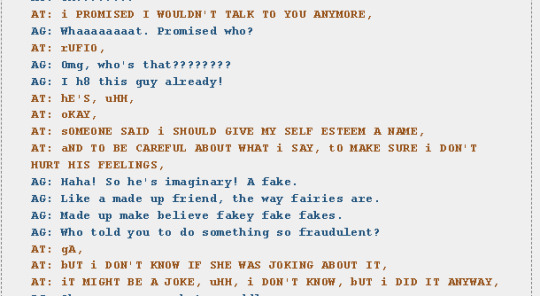

tavros's plurality is like, a pretty big factor in his character!!!! it's one of the bigger points vriska uses to bully him with (because she's projecting because she's projecting because she's projecting, because she's also plural and kins mindfang), it's like. a big thing that he has to cope with and figure out.
kanaya suggested tavros treat his self-confidence as his own brain guy, like, completely sincerely. she genuinely thought it would help, and it sorta did!!!!!
and like
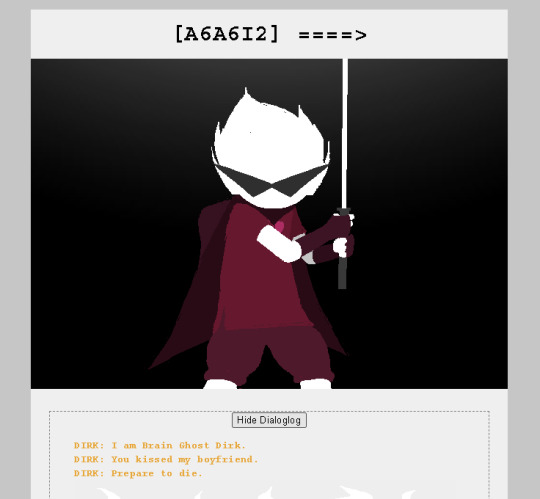
it is FAR from the only positive example of plurality in the comic.

like. look at sollux and aradia defending "alternate reality copies" of characters -- which can be pretty easily extrapolated to them talking about fictives


like. !!!!
i dunno, man. i think that homestuck is a DEEPLY plural story. you should read mtm and kgtac for more exploration of these themes. read detective pony too while you're at it. like.
i havent even TOUCHED on horuss or dirk or karkat here because there is just so much. there's so much! like ultselves. oh my god i completely neglected to talk about ultselves or cherubs or --
augh
but anyway here's The Screenshots from mtm


homestuck is, like, the single most fictive compatible fictional work i've ever read.
"oh im being sent to another universe as a brain ghost? that happened to my buddy dirk"
"oh im one of many incarnations of myself, and perhaps not even the most 'canon compliant' one? haha dream bubbles moment"
"ive been isekai'd into another world? lol sburb"
it. yeah. god. i could literally talk about this all day. but instead im gonna direct you to my ao3.
check out no metaphors and then scroll through the "multiplicity/plurality" tag on my page
and if youve got more specific stuff, send in another ask!
42 notes
·
View notes
Text
rory’s guide to where the howlters might move
i was talking with @underthisweather about this because we both play sims 4 and/or watch simmers that aren’t dan and phil play. there are a lot of people more well-versed in the sims 4 game and the dapg series than i am, but as someone who deliberately bought sims packs to get all the playable worlds, i can at least give it a guess.
i briefly considered making this a tier-list video but i have WAY too much on my plate to wrangle making a template and editing video right now, so quick post it is. i use all the world names, so feel free to look around youtube and other places online if you want to actually see the worlds.
Guidelines
this is all residential worlds, so vacation worlds and secret worlds aren’t being ranked. sorry, batuu (/j).
obviously, willow creek has been their home for a million years, so that’s not in the running, but i’ll talk about it a little bit before we get into the other worlds.
even though i’m not making a tier list video, i am making tiers because it’s fun. they are:
-top contenders: my best guesses for where dil, tabitha, dalien, and nuki land
-possible: not my guesses, but also i won’t be completely humiliated if they pick one of these
-for the bit: not likely, but if they have a particular joke or personal attachment or storyline in mind, that could keep them in the running
-nah: probably not happening
if you want to jump to the end and skip my blathering, that’s where the full tier list will be.
a quick primer as to what we’re talking about here:
-“worlds” are a group of neighborhoods sorted by a general theme or biome or both.
-“neighborhoods” are a group of buildings/spaces grouped into a loose theme. while sims 4 isn’t open world like sims 3, it has wandering spaces between lots that don’t require additional loading that form the connective tissue of the neighborhoods
-“lots” are where specific buildings/houses go. there are a variety of lots: residential, commercial, etc., and they can have specific traits to help or challenges to make things harder, much like you can give sims traits. residential is our main focus here
-each lot has a grid size. 64x64 is huge; 20x15 is a lot smaller.
here’s what they’ve told us about what’s going to happen, pulled directly from the transcript (timestamp):
Phil: We are gonna either build a house from scratch or buy a house, but we're moving.
Dan: We're shaking things up.
Phil: To a new neighborhood.
Dan: The Howlters are getting out of here. Look, it's that time. They lived a whole life. They were ready to retire. They got this three-bedroom massive house. They don't need all of this stuff.
Phil: They don't.
Dan: They need to start a new life in a new neighborhood now that their gay kids are out of there and they've got an emo and a Shiba Inu to raise.
Phil: Yeah. Think about it, though. We're gonna have new neighbors, new friendships, new experiences, new jobs.
generally what we know/can guess:
-prebuilt or custom-built residences are most likely, but they can also bulldoze and build on other kinds of lots without cheats. i summarize the amount of lots each neighborhood has to give you an idea of how many potential neighbors might be around.
-dan is implying they’re going to downsize, so a smaller lot seems likely
-it sounds like dil and tabitha will be getting new jobs? that probably won’t have a ton of impact on the world/lot because jobs are largely “go somewhere else to work and you either can watch or not” or “you work from home but the neighborhood doesn’t have much impact here”. still, good to know
-
Willow Creek
just wanna give a quick shoutout to willow creek, dil’s home world from the beginning. it’s a base game world, and it’s got a lot of goodies: excellent starter homes, three empty lots (the one they used is a 30x20, which is not as big as they get, but is also not the smallest), notable townies (pancakes family!), a nice park, and a little downtown area. the vibes are distinctly southern USA in biome and architecture
neighborhoods
sage estates: mansions! two residential lots (one occupied by default, one prebuilt empty).
pendula view: historic section, featuring the goths. four lots (three prebuilt, one empty 30x20).
courtyard lane: current home of the howlters and pancakes! in their game, all five lots have houses (shout out to the owl slide).
foundry cove: starter homes. five lots (four prebuilt, one empty 30x20).
crawdad quarter: park, museum, nightclub, gym, library
-
Oasis Springs
another base game world! VERY deserty, specifically with a slightly palm springs (southern CA, USA) vibe? they have a lot of vague deserts in the sims 4 without actually considering biome too deeply, which i can say because i’m a high-desert queer. anyway.
neighborhoods
acquisition butte: midcentury and kind of mission-style mansions. four residential lots (three prebuilt, one empty 40x30).
skyward palms: two residential lots with mansions.
bedrock strait: the description calls it “delightfully kitschy”. five residential lots (four prebuilt, one empty 30x20).
parched prospect: single-family homes similar to bedrock strait, maybe with less kitsch? five residential lots (four prebuilt, one empty 30x20)
mirage canyon: downtown area, with museum, lounge, park, gym, and bar.
upsides
i wouldn’t call dan and phil desert gays, but irl palm springs is pretty gay! there are a lot of options here to renovate that aren’t giant but aren’t tiny, either. the howlters could get invested in the landgraab drama, if they wanted. the weather is also a lot less rainy than most other words, which means fewer thunderstorms (a big plus for my gameplay, hard to say for them).
downsides
as previously stated, i don’t see dan and phil as desert gays. oasis springs isn’t their architectural style, and emo dalien would probably be miserable (this could be an upside for story reasons, but i’m leaning toward it not working specifically here). plus, oasis springs is an early sims world, and i feel like they’ll go newer for the fun of it.
tier ranking
i deliberated over this one for a second because it’s mostly a no, but i think it’s just possible enough to put in “Possible”. the very bottom, though.
-
Newcrest
honestly, i’m hesitant to call newcrest a world all its own because it’s basically willow creek without anything in it. there are no preset buildings here, just three neighborhoods with five empty lots.
neighborhoods
bridgeview: lots are 2 20x15, 2 30x20, 1 40x30
llama lagoon: lots are 1 30x20, 1 30x30, 2 40x30, 1 50x40
ridgeline drive: lots are 3 30x20, 1 40x20, 1 40x30
upsides
one word: versatility. i play here all the time because it’s easy to make a tiny home (my favorite way to build my sims’ skills) on the smallest lots and build a full town around them, complete with all the houses, neighbors, and lot types you want. for youtubers who are into storytelling, it’s very appealing.
downsides
i honestly don’t see dan and phil as youtubers who want to make their own towns. they could pull from the gallery entirely without taking up too much time, but that feels too stale for their playstyle and personal aesthetics, and i think they want to shake things up more. it wouldn’t even make a good “we said we were moving but we didn’t say it would be different” bit.
tier ranking
nah
-
Magnolia Promenade
technically possible, but i doubt it’s happening: it’s a similar style to willow creek with three retail lots and one empty 30x20 residential lot.
tier ranking
nah
-
Windenburg
the world that came with get together, which we know dan and phil have. quality-wise, it’s one of the best worlds in the whole game: a bunch of lots, beautiful architecture, variety in neighborhoods. it has a real northwestern european vibe.
neighborhoods
windslar: mix of large houses and smaller. six residential lots with one empty 40x30, and a chalet gardens lot, including hedge maze.
olde platz: old downtown of windenburg with a bunch of housing but no empty lots. four residential, bar, library, cafe, nightclub, and an ancient ruins lot.
lykke centre: new downtown of winderburg. park, cafe, gym, nightclub, and a giant pool.
the crumbling isle: rich people on an island! five residential lots with one empty 20x20.
upsides
versatility, but with structure. building a new house on that 20x20 island lot seems very possible to me, but they could take one of the empty prebuilts or evict someone easily. a lot of neighbors to mess with, and a lot of destinations to play in. i visit lykke center’s nightclub and pool in my games all the time.
downsides
not only would i say tudor is not dan and phil’s style (which is a lot of the non-mansion housing), i would say that, despite the slightly more germanic or nordic bent, it might be too familiar in some ways? but the bigger impediment i think is that it isn’t silly enough for their playstyle and doesn’t fit any of the characters. emo dalien probably won’t pub crawl, you know?
tier ranking
more “Possible” than oasis springs, but not the highest
-
San Myshuno
the world that came with city living, and dab and evan’s stomping grounds! big city and mostly apartment living.
neighborhoods
spice market: listed as a “family neighborhood”. six apartment units in two buildings, one 30x30 single-family house prebuilt, one karaoke bar.
arts quarter: the “bohemian” neighborhood where the humor and hijinks festival happens. six apartment units, including a penthouse, and an art museum.
fashion district: the “young and trendy” neighborhood where the romance festival and geekcon happen. six apartment units, including a penthouse, and a karaoke bar.
uptown: the “luxurious” neighborhood, with four apartment units, a gym, and a rooftop lounge. the city park’s next to this one.
upsides
we know this is VERY dan and phil because dab and evan already live here (and their place looks like the dnp manchester flat)! it would be very funny if dab’s parents showed up and we saw dnp playing dab like he was constantly annoyed they were cramping his style. i would also enjoy if they demolished the standalone house and built a city-style house like forever home. not that i’m trying to get a house tour by any means possible or anything.
downsides
this isn’t different enough, and that’s why i mostly think it won’t happen. i think it would only happen if dab and evan went elsewhere.
tier ranking
For the bit. i think they’ll go a different direction but they also can’t resist being self-referential, so i can’t rule it out entirely
-
Forgotten Hollow
the world that came with vampires. if you’ve watched this sims series in full, you’ve seen it before. i play in it constantly, but most people aren’t into occult sims like i am or build cemetery lots to keep all their dead sims. for some reason.
lots (because there aren’t distinct neighborhoods)
garliclauter place: empty prebuilt, 30x20, vampire nexus lot trait
vatore house: prebuilt, 30x30
vlad’s house: prebuilt, 40x30
fledermaus bend: empty lot, 30x30
widowshild townhome: prebuilt, 30x20, registered vampire lair lot trait
there’s also some non-lot space that’s fun to hang out in, like the central park (that isn’t a park lot) and wilderness behind most of the lots
tier ranking
just skipping to this because it’s an easy “nah”: they’ve been here before and purely did it as an alternate-universe spooky week episode.
-
Brindleton Bay
the world that came with dogs and cats (and the first canon gay sim townies)! we know they have it because nuki exists. rainy seaside vibes.
neighborhoods
sable square: listed as both the “cultural center” of the world, but as a “monument” to their pets. three residential lots with one empty 30x20, a park with the dog-friendly lot trait, and a vet clinic.
cavalier cove: seaside residential of varying sizes. five residential lots with two empty 30x20s.
whiskerman’s wharf: touristy downtown wharf. three residential lots with one empty 40x30, a bar, and a lounge.
deadgrass isle: island with a museum lot. also has a lighthouse i think you can run around in, but i haven’t tried it.
upsides
if they were doing nuki-focused story or were looking to fill a house entirely with cats and dogs, this would be the place to go. maybe the howlters could have gay friends and live next door to the heckings! dan and phil yelling about the feral/townie cats would be a delight.
downsides
honestly, i’m just not a huge fan of this world. it never runs well on my computer, it rains all the time (which i like in real life, but not the sims), and if i have pets, i’m always in the vet clinic getting that stuff to work. obviously this is a ymmv thing, but i think it’s too bland for dan and phil as well.
tier ranking
low in “Possible”. i think oasis springs makes more sense, honestly.
-
Del Sol Valley
the world from get famous, which is basically a giant los angeles clone.
neighborhoods
mirage park: three residential lots, including one empty 50x40
starlight boulevard: the downtown area. two lounges, one museum, one nightclub, one park.
the pinnacles: mansion area. three prebuilt residential lots.
tier ranking
i’m gonna put this in “nah” quickly because dab is pursuing the actor career and might come here if he wants fame, but it’s more of a world to visit than live in. i don’t hate it or anything, but there’s few sims to interact with, and it wasn’t well-built. (one of the mansions has no bathrooms!) i think the only potential spoiler here is if dan and phil (mostly dan) wanted an outlet to rant about the entertainment industry, but they can do that without moving to del sol valley.
-
Strangerville
came with the pack of the same name! this is different than every other world because there’s a built-in narrative about the government and weird behavior, but it also has the neighborhood structure.
neighborhoods
secret lab: this is part of the narrative and is a single lot, but it gets its own neighborhood mention because, if you look up the map, it takes up the entire upper left corner.
shady acres: rich part of strangerville. five residential lots with two empty 30x20s.
strangerville plaza: main part of strangerville. four prebuilt residential lots, one library, and one bar.
upsides
honestly, that i have any is going to probably set me apart from any sims player-dapg fan combo. i think the red desert look is nicely different from the willow creek look, the build items are sometime underrated, and dan’s area 51 reference in the latest video could have been a hint. dil has been super close to alien weirdness; might as well follow that to its logical conclusion!
downsides
i don’t actually think dan and phil will do strangerville’s story because they want something a little more different. the richer housing in this world isn’t super well-built, and i can’t imagine them building a trailer in a trailer park for fun (although they should; i enjoy those kinds of build videos a lot).
tier ranking
For the bit
-
Sulani
the world that came with island living, probably most directly inspired in style by hawaii. this is a fun one because one of the neighborhoods is built on a volcano, multiple lots include sections of water, and you can turn into a mermaid! or, you know, just have a drink on the beach.
neighborhoods
lani st. taz: four residential lots including one empty 50x50, and a beach lot
mua pel’am: the volcano neighborhood! three residential lots, including one empty 40x30, and a lot of fun exploratory territory.
ohan’ali town: main town area. four prebuilt residential lots, one beach lot, one bar
upsides
very different than willow creek, good if they want to pursue a “dil and tabitha are kind of retired and immortal, why not go to the beach” storyline, generally just a good world.
downsides
if “pale nerds move to the desert” is a bad idea, “pale nerds move to the beach” isn’t much better. the off-the-grid options seem VERY unlikely!
tier ranking
no offense to sulani, but “nah” seems most likely
-
Glimmerbrook
realm of magic’s residential world! (there’s a portal to another world in this one, but you can’t live there without mods/cheats.) another world where i like it in theory, but the construction could be better, and it’s mostly centered around an occult type.
lots
glimmerbrook watch: empty 30x20
charm family: residential 40x20
amicable acolytes: residential 30x20
brooks bridge borough: residential 30x20
elixirs and brews: bar
tier ranking
nah
-
Britechester
discover university’s world! most of the housing here is specifically for students, but not all of it.
neighborhoods
foxbury university: the newer school! four university housing lots
gibbs hill: the town part of the college town. three prebuilt housing lots, one bar, and one library.
university of britechester: the older school. four university housing lots
tier ranking
i’m putting this in “Top contenders” with an asterisk: i don’t think it’ll happen yet, and if/when it does happen, it’ll be because dalien graduated high school and moved to university, which was implied in the latest video to be a likely path for dalien. my understanding is that university plays work better if the students live out of the world, but imagine dan and phil passing up a chance to talk about their uni experiences. i bet dalien will live his conflicted alien life in the dorms, at least to start with.
-
Evergreen Harbor
eco lifestyle’s world! it doesn’t have a strict narrative like strangerville does, but it’s built specifically for residents to vote on community initiatives and with mechanics that change the look depending on how environmentally conscious everyone’s being.
neighborhoods
grims quarry: former quarry turned residential neighborhood. three prebuild single-family lots and one apartment lot.
port promise: former industrial port trying to be reclaimed by the community. three prebuilt residential lots, one bar, one community space.
conifer station: former train area turned residential. two prebuilt residential lots, one apartment space, one community space.
upsides
i honestly think this one has a lot of potential, both in regards to dan and phil’s tastes and storyline options. going from strict scientist toward environmentalist would be a great route for dil, and the household could live in an apartment without being in the city, if they felt like downsizing that much. dan specifically has a reformed nihilist vibe that would go really well here, and dumpster diving/woohooing is a LOT of fun.
downsides
maybe not glamorous enough? dalien would probably hate it, which is not a hard no for me lol. they might want a world with more neighbors to torment, too. i’m also not sure if dan and phil have eco lifestyle, are interested, or even really know about it.
tier ranking
Top contenders, even if dan and phil don’t know it
-
Mt. Komorebi
snowy escape’s world, which is definitely japanese in influence, but not tokyo: it’s specifically more rural mountain areas. it’s also unique in that it’s half residential world, half vacation world, and the mountain is snowy even if you don’t have the seasons pack.
neighborhoods
yukimatsu: mountain peak with ski slopes! two rental lots, one onsen bathhouse, and one empty residential 50x50.
senbamachi: old part of town. three prebuilt residential lots, one bar, one park.
wakaba: new part of town. three residential lots, including one empty 20x15, one lounge, one rental.
upsides
look, it’s japan. dan and phil like japan (to put it mildly) and this pack melds older style with modern luxury real well. the builds are really solid as well; this was around the time when the sims team got simmers involved in making buildings, and it makes a big difference. the one time i played with dan and phil sims, they lived in mt. komorebi.
downsides
the combination of sports and vacation makes this a bit less likely as a moving destination, i think.
tier ranking
For the bit. it’s borderline imo, but if they go here, it will largely be because dan and phil love japan.
-
Henford-on-Bagley
cottage living’s world, which is very deliberately rural england in style.
neighborhoods
the bramblewood: mostly woods, with some buildings. three prebuilt residential lots, one park.
old new henford: the real farming neighborhood. four residential lots, including one empty 50x40.
finchwick: the village. two residential lots and one bar.
tier ranking
nah. if i think windenburg might be too familiar, henford-on-bagley definitely is, and i doubt they’ll do farming gameplay.
-
Tartosa
the world for the still-broken wedding stories pack! mediterranean in inspiration, mostly italy, i think.
neighborhoods
terra amorosa: waterfall, bridge, and buildings. three residential lots, including one empty 30x30, and one wedding venue.
porto luminoso: seaside town. three residential lots, including one empty 40x20, one rental lot, and one lounge.
tier ranking
nah. if we go here, it’ll be for the devan wedding, but even then i don’t think it’s super their style. (tbf i haven’t played here a ton, but the lounge is fun to visit)
-
Moonwood Mill
the werewolf pack’s world! i think this is a bit more liveable for most people than the vampire world, if only because there’s some variety in building type, but it’s still an occult pack.
lots
volkov house: occupied residential, 40x30
new moon shack: empty prebuilt residential, 20x15
the moonwood mill library: library
grimtooth bar and bunker: bar
prowler’s patch: empty residential lot, 30x30
tier ranking
nah. can i will another alternate universe episode like the vampire one into being, though?
-
Copperdale
the high school years world! mountain western united states vibe with a lake dividing the town in two. the map is beautiful, honestly.
neighborhoods
rockridge heights: the high school gets its own two-part neighborhood, divided into a high school building for regular school gameplay and an auditorium for things like prom, graduation, and a job fair.
prescott square: downtowny area. three prebuilt residential lots, one library, one thrift and bubble tea store (random, but high school years comes with thrifting as a money-making opportunity for teens).
plumbite cove: waterside area. three residential lots, including one empty 20x20, one rental, and one park, but my favorite part is the rabbit hole amusement park (you don’t get to see anyone go on the rides, but it’s a common afterparty destination).
upsides
if you ask me, this is the most likely neighborhood for howlter relocation! they specifically referenced high school years as dalien’s next stop, there’s a small empty lot to build on, it’s one of the newer sims expansions, and it’s different enough from willow creek to make it interesting while not reinventing the wheel. the social opportunities for dalien will be big! even if they don’t move here, we’re definitely going to see it a lot.
downsides
i do think dan and phil’s tastes have gotten more upscale over the years, so they outgrew willow creek, and copperdale might be a little quaint/small for them, too. doesn’t change the fact that dil and tabitha still have a teen.
tier ranking
Top contenders
-
San Sequoia
the growing together world! seaside town grown up; probably san francisco bay area since lots have the quake zone trait, “sequoia” implies that biome, and the map has a big bridge on it.
neighborhoods
anchorpoint wharf: downtown area. two residential lots, including an empty 30x20, one library, and one rental.
gilbert gardens: family recreation spot. three residential lots, including an empty 40x20, and one recreation center.
hopewell hills: more suburban. four residential lots, including an empty 30x20.
upsides
family space with a lot of options to build and annoy/clone neighbors, while not sacrificing a more urban feeling. plus, it’s the second most recent pack, which means it still feels fresh to a lot of people.
downsides
i’ll be honest, i thought san sequoia was a slam dunk when i was conceptualizing this post. but now that i’ve gone through all the other worlds, i think it’s honestly too young for the howlters. dalien is not splash pad age, for sure. i think it’s still a solid contender, but i would be a bit surprised if it gets picked.
tier ranking
Possible
-
Chestnut Ridge
horse ranch’s shiny new western US desert world! i’d say the red rock and hills makes i more utahish versus the southern california (oasis springs) and maybe arizona (strangerville) deserts. can i get one brushy high-desert landscape, please? anyway.
neighborhoods
galloping gulch: hilly living. two residential lots and one rental.
new appaloosa: downtown in yeehaw style. two residential lots, one nightclub, one bar, and a notable rabbit-hole arena for horse training next to the park.
riders’ glen: ranch and vineyard spaces. five residential lots with one empty 64x64.
tier ranking
let’s just jump to it: unless dan and phil get a hankering for dil and tabitha to ride horses or crush grapes, i suspect chestnut ridge will only possibly be a destination for dab and evan as brokeback mountain jokes. “For the bit” with an asterisk, it is!
-
Top contenders
Copperdale, Evergreen Harbor, Britechester*
Possible
Windenburg, San Sequoia, Oasis Springs, Brindleton Bay
For the bit
Mt. Komorebi, San Myshuno, Strangerville, Chestnut Ridge*
nah
Del Sol Valley, Sulani, Tartosa, Henford-on-Bagley, Newcrest, Glimmerbrook, Moonwood Mill, Forgotten Hollow, Magnolia Promenade
* = not right away
#finally got this 4k+ monster ready to go#thanks to dnp for not posting spooky week today and giving me a lull lol#this is all my opinions: i'd love to hear other sim players' thoughts!#will they prove me wrong and move the howlters to sulani? lol#i'm excited to find out#my ramblings#sims#dapg
47 notes
·
View notes